![[ภาพประกอบแสดงนางฟ้ากำลังดูแลสวน]](https://www.gutenberg.org/cache/epub/67175/images/i28.jpg)
LEGEND LAND
Being a collection of some of the
OLD TALES told in those Western
Parts of Britain served by the
GREAT WESTERN RAILWAY, now
retold by LYONESSE

VOLUME ONE
Published in 1922 by
THE GREAT WESTERN RAILWAY
[FELIX J. C. POLE, GENERAL MANAGER]
PADDINGTON STATION, LONDON
CONTENTS AND ILLUSTRATIONS
This is a reprint in book form of the first series of The Line to Legend Land leaflets, together with a Supplement, "The Furry Day Song."
The Map at the beginning provides a guide to the localities of the six Cornish legends and the "Furry Day Song"; that at the back to the six stories of Wales.
Printed by Spottiswoode, Ballantyne & Company Limited,
One New Street Square, London, E.C.4
FOREWORD
In those older, simpler days, when reading was a rare accomplishment, our many times great-grandparents would gather round the blazing fire of kitchen or hall on the long, dark winter nights and pass away the hours before bedtime in conversation and story-telling.
The old stories were told again and again. The children learned them in their earliest years and passed them on to their children and grandchildren in turn. And, as is natural, in all this telling the stories changed little by little. New and more familiar characters were introduced, or a story-teller with more vivid imagination than his fellows would add a bit here and there to make a better tale of it.
But in origin most of these old legends date from the very dawn of our history. In a primitive form they were probably told round the camp-fires of that British army that went out to face invading Cæsar.
Then with the spread of education they began to die. When many folk could read and books grew cheap there was no longer the need to call upon memory for the old-fashioned romances.
Yet there have always been those who loved the old tales best, and they wrote them down before it was too late, so that they might be preserved for ever. A few of them are retold briefly here.
All people should like the old stories; all nice people do. To them I commend these tales of Legend Land, in the hope that they may grow to love them and the countries about which they are written.
LYONESSE
THE MERMAID OF ZENNOR
Carved on one of the pews in the church of Zennor in West Cornwall is a strange figure of a mermaid. Depicted with flowing hair, a mirror in one hand and a comb in the other, the Zennor folk tell a strange story about her.
Years and years ago, they say, a beautiful and richly dressed lady used to attend the church sometimes. Nobody knew where she came from, although her unusual beauty and her glorious voice caused her to be the subject of discussion throughout the parish.
So attractive was she that half the young men of the village fell in love with her, and one of them, Mathey Trewella, a handsome youth and one of the best singers in the neighbourhood, determined that he would discover who she was.
The beautiful stranger had smiled at him in church one Sunday, and after service he followed her as she walked away towards the cliffs.
Mathey Trewella never returned to Zennor, nor did the lovely stranger ever attend church again.
Years passed by, and Mathey's strange disappearance was almost forgotten when, one Sunday morning, a ship cast anchor off Pendower Cove, near Zennor. The captain of the vessel was sitting idling on the deck when he heard a beautiful voice hailing him from the sea. Looking over the side he saw the mermaid, her long yellow hair floating all around her.
She asked him to be so kind as to pull up his anchor, for it was resting upon the doorway of her house [6]under the sea and she was anxious to get back to Mathey, her husband, and her children.
In alarm, the captain weighed anchor and stood out to sea, for sailors fear that mermaids will bring bad luck. But later he returned and told the Zennor folk of Mathey's fate, and they, to commemorate the strange event, and to warn other young men against the wiles of the merrymaids, had the mermaid figure carved in the church.
And there it is to-day for all the world to see, and to prove, to those who do not believe the old stories, the truth of poor Mathey Trewella's sad fate.
Zennor is a lovely moorland village in the neighbourhood of some of the wildest scenery in Cornwall. To the south-west rugged moors stretch away to the Land's End. To the north a quarter of an hour's walk brings you to the coast with its sheltered coves and its cruel cliffs. Gurnard's Head, one of the most famous of all Cornish promontories, is less than two miles away. Grim, remote, yet indescribably fascinating, the country around Zennor is typical of that far western corner of England which is swept continually by the great health-giving winds of the Atlantic.
In its sheltered valleys flowers bloom all the year round. On its bold hill-tops, boulder-strewn and wild, there remain still the old mysterious stones and the queer beehive huts erected by men who inhabited this land in the dark days before Christianity.
Gorse and heather riot over the moorland. There [7]is a charm and peace about this too little known country that compels health and well-being.
Yet Zennor is only five and a half miles by the moorland road from St. Ives, that picturesque little fishing town that artists and golfers know so well. St. Ives, less than seven hours' journey from Paddington, is an ideal centre from which to explore the coast and moorland beauties of England's furthest west.
THE STONE MEN OF ST. CLEER
A thousand feet above sea level among the heather and bracken of Craddock Moor, four or five miles north of Liskeard, you may find to-day the remains of three ancient stone circles known as "The Hurlers." Antiquaries will tell you that the Druids first erected them, but the people of the countryside know better. From father to son, from grandparent to child, through long centuries, the story has been handed down of how "The Hurlers" came to be fixed in eternal stillness high up there above the little village of St. Cleer.
Exactly how long ago it was nobody knows, but it happened in those early days when pious saints were settling down in the remote parts of savage Cornwall and striving to convert the wild Cornish from their pagan ways.
Then, as even to this day, the game of Hurling—a sort of primitive Rugby football—was a popular pastime with the people. Village used to play against village, with goals perhaps four or five miles apart. And the good folk of St. Cleer were as fond of the game as any of their neighbours—so fond, in fact, that they would play it on any and every occasion, despite the admonitions of their local saint and parson, after whom the village was named.
Again and again he would notice that his little church was empty on Sunday mornings while the shouts and noise of a hard-fought Hurling match drifted across the moorland in through the open church door. Again and again he would take his flock [10]to task for their godless ways and their Sabbath-breaking games. But it was of little use. For a Sunday or two they would be penitent and attend service. Then would come a fine morning, and a challenge perhaps from the Hurlers of St. Ive or North Hill, on the other side of the moors, and the young men would decide to chance another lecture from the patient saint, and out they would go to the hillside to do battle for the honour of their parish.
But even the patience of saints comes to an end at last, and good St. Cleer saw something more than words was needed to lead his people into the right way. And so it happened one Sunday morning, in the midst of a hot tussle on Craddock Moor, the outraged St. Cleer arrived in search of his erring flock.
He bade them cease their game at once and return to church. Some of them obeyed, wandering sheepishly off down the hill; some were defiant and told the worthy man to go back to his prayers and not to come up there to spoil sport.
Then St. Cleer spoke in anger. Raising his staff he told them in solemn and awful tones that it should be as they had chosen. Since they preferred their game on the moor to their service in church, on the moor at their game they should stay for ever. He lowered his staff and to the horror of all onlookers the defiant ones were seen to be turned into stone.
Many centuries have passed since then. Time, wind and rain have weathered the stone men out of all semblance of humanity. Some have been destroyed, but most still remain as an awful example [11]to impious Sabbath profaners. And there you may see them silent and still, just as they were struck on that grim Sunday in the dark long ago.
The glorious moorland, rugged and wild, stretches all about them—a wonderful walking country, where one may escape from all cares and wander for hours amid the bracken and sweet-smelling grasses and find strange prehistoric remains seldom visited by any but the moorland sheep and the wild birds. It is a country of vast spaces and far views. You may see on one hand the Severn Sea, on the other the Channel; to the east the upstanding blue hills of Dartmoor and to the west the rugged highlands by Land's End—and then trudge back at night weary but happy to Liskeard, described as "the pleasantest town in Cornwall," and find it hard to believe that only five hours away is the toil and turmoil of London.
HOW ST. PIRAN CAME TO CORNWALL
Some sixteen hundred years ago, so tradition tells, there lived in the South of Ireland a very holy man named Piran. Such was his piety that he was able to perform miracles. Once he fed ten Irish kings and their armies for ten days on end with three cows. Men sorely wounded in battle were brought to him to be cured, and he cured them. Yet the Irish grew jealous of his power and decided he must be killed.
And so one stormy, boisterous morning the pious [13]Piran was brought in chains to the summit of a high cliff, and with a huge millstone tied to his neck his ungrateful neighbours hurled him into the raging billows beneath. This horrible deed was marked, as the holy man left the top of the cliff, with a blinding flash of lightning and a terrifying crash of thunder, and then, to the amazement of the savages who had thus sought to destroy him, a wonderful thing happened.
As man and millstone reached the sea the storm instantly ceased. The sun shone out, the waves and the wind died down, and, peering over the edge of the cliff, the wondering crowd saw the holy man, seated peacefully upon a floating millstone, drifting slowly away in the direction of the Cornish shore, some hundreds of miles to the south-east.
St. Piran's millstone bore him safely across the Atlantic waves until at length—on the fifth day of March—it grounded gently upon the Cornish coast, between Newquay and Perranporth, on that glorious stretch of sand known to-day as Perran Beach. Here the Saint landed, and, taking his millstone with him, proceeded a little distance inland and set himself to work to convert the heathen Cornish to Christianity.
He built himself a little chapel in the sands and lived a useful and pious life for many years, loved by his people, until at last, at the great age of two hundred and six, he died. Then his sorrowing flock buried him and built over his grave St. Piran's Chapel, the remains of which you can see to-day hidden away in the sandhills of the Penhale Sands.
Although Cornwall can boast many saints, St. Piran has greater right than any other to be called the patron of the Duchy. To him the Cornish in the old days attributed a vast number of good actions, among them the discovery of tin, the mining of which has for centuries formed one of the chief Cornish industries.
This came about, according to the old story, from the saint making use of some strange black stones that he found, to make a foundation for his fire. The heat being more intense than usual one day, these stones melted and a stream of white metal flowed from them.
The saint and his companion, St. Chiwidden, told the Cornish people of their discovery, and taught them to dig and smelt the ore, thus bringing much prosperity to the country, the story of which eventually reached the far-away Ph[oe]nicians and brought them in their ships to trade with the Cornish for their valuable metal.
Good St. Piran has left his name all over the wonderful country south-west of Newquay. In Perranporth, with its rocks and caves and glorious bathing beach; in St. Piran's Round, that strange old earth-work not far away; in the parish of Perranzabuloe, which means Perran in the Sands; in Perranwell, near Falmouth, and even further south in Perranuthnoe, which looks out across the waters of Mounts Bay.
But although memorials of him are to be found over most of South Cornwall, it is the district of the [15]Perran Sands, where he landed, lived and died, that is his true home. There, where the soft Atlantic breezes or the fierce winter gales sweep in to Perran Bay, you may look out over the dancing sea towards Ireland and America with nothing but Atlantic rollers between, or wander amid the waste of sand dunes that comprise the Perran Sands and breathe in health with every breath you take.
Perranporth is on the edge of these sandhills, which stretch away north-east to within four miles of Newquay—all within seven hours' journey from London.
THE LOST CHILD OF ST. ALLEN
They never talk of fairies in Cornwall; what "foreigners" call fairies the Cornish call "piskies," or "small people." And all about the Duchy piskies still abound for those who are fitted to see them. The old folk will still tell you many strange stories of the piskies. One of the best known is that of the lost child of St. Allen. St. Allen is a parish on the high ground about four miles from Truro, and there, in the little hamlet of Treonike, or, as it is now called, Trefronick, on a [17]lovely spring evening years and years ago, a small village boy wandered out to pick flowers in a little copse not far from his parents' cottage.
His mother, looking from the kitchen door, saw him happily engaged in his innocent amusement, then turned to make ready the supper for her good man, whom she saw trudging home in the distance across the fields. When, a few minutes later, she went to call her boy in to his evening meal, he had vanished.
At first it was thought that the child had merely wandered further into the wood, but after a while, when he did not return, his parents grew alarmed and went in search of him. Yet no sign of the boy was discovered.
For two days the villagers sought high and low for the missing child, and then, on the morning of the third day, to the delight of the distracted parents, their boy was found sleeping peacefully upon a bed of fern within a few yards of the place where his mother had last seen him. He was perfectly well, quite happy, and entirely ignorant of the length of time that had elapsed. And he had a wonderful story to tell.
While picking the flowers, he said, he had heard a bird singing in more beautiful tones than any he had heard before. Going into the wood to see what strange songster this was, the sound changed to most wonderful music which compelled him to follow it. Thus lured onward he came at length to the edge of an enchanted lake, and he noticed that night had fallen but that the sky was ablaze with huge stars. [18]Then more stars rose up all around him, and, looking, he saw that each was in reality a pisky. These small people formed themselves into a procession, singing strange fascinating songs the while, and under the leadership of one who was more brilliant and more beautiful than the rest they led the boy through their dwelling place. This, he said, was like a palace. Crystal pillars supported arches hung with jewels which glistened with every colour of the rainbow. Far more wonderful, the child said, were the crystals than any he had seen in a Cornish mine.
The piskies were very kind to him, and seemed to enjoy his wonder and astonishment at their gorgeous cave. They gave him a fairy meal of the purest honey spread on dainty little cakes, and when at last he grew tired numbers of the small folk fell to work to build him a bed of fern. Then, crowding around him, they sang him to sleep with a strange soothing lullaby, which for the rest of his life he was always just on the point of remembering, but which as certainly escaped him. He remembered nothing more until he was awakened and taken home to his parents.
The wise folk of St. Allen maintained that only a child of the finest character ever received such honour from the small people, and that the fact that they had shown him the secrets of their hidden dwelling augured that for ever afterwards they would keep him under their especial care. And so it was; the boy lived to a ripe old age and prospered amazingly. He never knew illness or misfortune, and died at last in his sleep; and those that were near him say that as [19]he breathed his last a strange music filled the room. Some say that the piskies still haunt the woods and fields around Trefronick, but that they only show themselves to children and grown-ups of simple, trusting nature. Anyhow, those that wish to try to see them may reach the place where the lost child was spirited away in an hour and a half's walk from Truro, Cornwall's cathedral city, which is at the head of one of the most beautiful rivers in the world.
The trip from Truro down the Truro river and the Fal to Falmouth at any time of the year is a pleasurable experience that can never be forgotten. Truro is an ideal centre for South Cornwall. Wild sea coast and moorland, and woods and sheltered creeks, are all close at hand, yet the city itself has the cloistered calm peculiar to all our cathedral towns.
The tourist neglects Truro too much, for as a lover of the Duchy once said: "It is the most convenient town in Cornwall; it seems to be within an hour and a half's journey of any part of the county."
THE GIANTS WHO BUILT THE MOUNT
St. Michael's Mount, that impressive castle-crowned pyramid of rock that rises from the waters of Mounts Bay, was not always an island. In fact, it is not always an island now. At low tide you may reach it from the mainland along a causeway. But once upon a time the Mount stood in the midst of a forest; its old name, "Caraclowse in Cowse," means "the Grey Rock in the Wood," and that was at the time when the Giants built it.
Cormoran was one of the Giants; he lived in this great western forest, which is now swallowed up by the sea, and there he determined to erect for himself a stronghold that should rise well above the trees. So he set to work to collect huge stones from the neighbouring granite hills, and his new home grew apace.
But the labour of searching far afield for suitable stones, and of carrying them to the forest and piling them one upon another, was a wearying task even for a giant, and as Cormoran grew tired he forced his unfortunate Giantess wife, Cormelian, to help him in his task, and to her he gave the most toilsome of the labour.
Was there a gigantic boulder in a far part of the Duchy that Cormoran coveted, unhappy Cormelian was sent to fetch it; and she, like a dutiful wife, never complained, but went meekly about her work, collecting the finest and biggest stones and carrying them back to the forest in her apron. Meanwhile Cormoran, growing more lazy, spent much of his time in sleep, waking up only very occasionally to admonish his wife or to incite her to greater efforts.
One day, when Cormelian had been twice as far as the Bodmin moors to fetch some particularly fine stones Cormoran had seen, and was about to set off on a third journey, she, noticing her husband fast asleep, thought to save herself another weary walk by going only a short distance and breaking off some huge masses of greenstone rock which existed in the neighbourhood and placing them upon the nearly [22]completed Mount without being seen. Although Cormoran had insisted that the stone be grey, Cormelian could see no reason why one stone was not as good as another.
So, carrying out her plan, she was returning with the first enormous piece of greenstone, walking ever so carefully so as not to awaken Cormoran, when, unfortunately, he did awake. He flew into a terrible rage on seeing how his wife was trying to delude him, and, rising with a dreadful threat, he ran after her, overtaking her just before she reached the Mount.
Scolding her for her deceit, he gave her a terrific box on the ear. Poor Cormelian, in her fright, dropped the huge greenstone she was carrying, and ran sobbing from her angry husband to seek refuge in the deepest part of the forest; and it was not until Cormoran himself had finished building the Mount that she would return to him.
And to-day, as you walk along the causeway from Marazion to St. Michael's Mount, you will see on your right hand an isolated mass of greenstone, the very rock that Cormelian dropped. It is called Chapel Rock now, because years and years afterwards, when pious monks lived upon the summit of the Mount and devout pilgrims used to visit their church to pay homage at a shrine, they built a little chapel, upon poor Cormelian's green rock, of which only a few stones now remain.
You may visit Chapel Rock and St. Michael's Mount from Penzance, which is between three and [23]four miles away and is the ideal centre for some of the most wonderful scenery in Cornwall. Both Land's End and the Lizard are within easy reach of this, England's westernmost town, where a climate that rivals that of the Mediterranean may be enjoyed in the depth of winter. Semi-tropical flowers and trees bloom in the open, and in February and early March—in what is, in fact, winter weather for those in less favoured parts—Penzance and its neighbourhood are surrounded by glorious spring flowers, the growing of which forms a very considerable industry.
London and our other big towns often get their first glimpse of coming spring in the narcissi and wallflowers grown around the shores of Mounts Bay, and packed off to the grim cold cities only a few hours away.
THE TASKS OF TREGEAGLE
The name of the demon Tregeagle is a household word in nearly every part of Cornwall. His wild spirit rages of nights along the rocky coasts, across the bleak moors and through the sheltered valleys. For Tregeagle is a Cornish "Wandering Jew"; his spirit can never rest, since in life he was the most evil man the Duchy ever knew.
His story, as the legend has it, is that he was a man who amassed great wealth by robbing his neighbours [25]in the cruellest manner. As he approached the end of his most evil life remorse seized him. There was no sin he had not committed, and hoping to escape from the just reward of so wicked a life, in the hereafter, he lavished money upon the Church and the poor, trusting to obtain the help of the holy priests to save him from the clutches of the Evil One.
The priests, ever anxious to save a soul, banded themselves together, and by constant prayer and powerful exorcisms kept the powers of darkness at bay, and Tregeagle died and was buried in St. Breock Church. But the demons were not so ready to give up what they felt was their lawful prey. An important lawsuit occurred shortly after his death, and as the judge was about to give his decision against the unjustly accused defendant, to the horror of all in court, the gaunt figure of the dead Tregeagle stalked into the room. His evidence saved the defendant.
Now Tregeagle being brought from the grave, despite the honesty of his mission, placed himself once more in danger of the demons. The defendant, who had raised the spirit, calmly left him to the Churchmen to put once more to rest, and after a long conference, presided over by the Prior of Bodmin, it was decided that the only hope of ultimate peace for the evil man's spirit was that he be set to some task which might last until the Day of Judgment. And so long as he worked unceasingly at that task he might still hope for salvation.
So the task appointed him was to empty out [26]Dozmary Pool, a gloomy lake on the Bodmin Moors, with a limpet-shell with a hole in it. For years Tregeagle laboured at this, until one day during a terrible storm he ceased work for a moment. Then the demons descended upon him. He fled from his pursuers, and only escaped them by leaping right across the lake—for demons cannot cross water—and rushing for sanctuary to the little chapel on the Roche Rock, where he managed just in time to get his head in at the east window. But the howls of the demons outside, and the roaring of the terrified Tregeagle within, made the life of the unfortunate priest of the Roche chapel unbearable, and he appealed to his brethren of the Church to do something about it. So they bound the wicked spirit with holy spells and took him safely across to the north coast, where another task was set him. He was to weave a truss of sand and spin a sand rope to bind it with. But as soon as he started on his work the winds or the waves destroyed it, and the luckless creature's roars of anger so disturbed the countryside that the holy St. Petroc was prevailed upon to move him once more, to a wilder part of the country, and the saint took him to the coast near Helston.
Here Tregeagle was set to the task of carrying all the sand from the beach below Bareppa across the estuary of the Looe river to Porthleven, for St. Petroc knew that each tide would sweep the sand back again and the task could never be completed. But the demons were always watching Tregeagle, and one of them contrived one day to trip him up as he was [27]wading across the river. The sand poured from the huge sack Tregeagle was carrying and dammed up the stream, thus forming the Looe Pool, which you may see to-day just by Helston, and the Looe Bar, which separates it from the sea.
Tregeagle's next task he is engaged upon to-day. He was taken to near the Land's End, and there he is still endeavouring to sweep the sand from Porthcurnow Cove round the headland of Tol-Peden-Penwith into Nanjisal Bay, and on many a winter night if you are there you can hear him howling and roaring at the hopelessness of his task.
These scenes of Tregeagle's labours are all situated amid most glorious scenery. Dozmary Pool, bleak and lonely amid the Bodmin Moors, the little chapel on the Roche Rock near St. Austell, and the beautiful Looe Pool by Helston, that attractive little town on a hillside, which is the tourist centre for that country full of colour, deep sheltered valleys, and magnificent coast scenery, the Lizard peninsula.
Porthcurnow, the miserable man's present abode, you will find nestling amid the grim cliffs near the Land's End. And if you doubt this sad history of the demon-ridden Tregeagle, go and look at the Looe Bar and explain if you can how otherwise so strange a place could have been created.
THE LADY OF LLYN-Y-FAN FACH
Not many miles from Llandovery, in the midst of glorious mountain scenery, is a lovely little lake known as Llyn-y-Fan-Fach, the scene of a very remarkable occurrence. Once upon a time a simple cowherd, eating his frugal meal by the edge of the water, observed with amazement, seated upon the calm surface of the lake, the most beautiful woman he had ever seen. So great was his admiration for her that he cried out, and she, turning to him, gave a rapturous smile and silently disappeared beneath the waters.
The peasant was distracted, for he had fallen deeply in love with the beautiful lady. He waited until dark, but she did not appear again; but at daybreak the next morning he returned once more, and was again rewarded by the sight of his enchantress and another of her alluring smiles.
Several times more he saw her and each time he besought her to be his wife, but she only smiled and disappeared, until at length one evening, just as the sun was setting, the beautiful lady appeared, and this time, instead of diving beneath the surface, she came to the shore, and, after some persuasion, consented to marry the youth. But she made one condition: if ever he should strike her three blows without cause she would leave him, she said, and their marriage would be at an end.
So the two were married happily and went to live at Esgair Laethdy, near Myddfai, the maiden bringing with her as dowry a large number of cattle and horses which she called up from the bottom of the lake.
For years the couple lived in great prosperity and happiness, and three handsome sons were born to them; then the day arrived when husband and wife were setting out for a christening, and, being rather late, the husband slapped his wife merrily on the shoulder, urging her to hurry. Sadly she reminded him that he had struck her the first of the causeless blows.
Years passed by, and the couple were at a wedding. In the midst of all the merry-making the wife burst suddenly into tears. Patting her sympathetically on the arm, the man inquired the cause of her weeping, and she, sobbing the harder, reminded him that he had struck her a second time.
Now that he had only one chance left, the husband was particularly careful never to forget and strike the third and last blow; but, after a long while, at a funeral one day, while all were sobbing and weeping, the beautiful lady suddenly began laughing merrily. Touching her gently to quiet her, the husband realised that the end had come.
"The last blow has been struck; our marriage is ended," said the wife, now in tears; and with that she started off across the hills to their farm. There she called together her cattle and other stock, which immediately obeyed her voice, and, led by the beautiful lady, the whole procession moved off across the mountains back to the lake.
Among the animals was a team of four oxen which were ploughing at the time. They followed, too, plough and all, and, they say, to this very day you may [31]see a well-marked furrow running right across the Myddfai mountain to the edge of Llyn-y-Fan-Fach, which proves the truth of this story.
The disconsolate husband never saw his lady again, but she used sometimes to appear to her sons, and she gave them such wonderful knowledge that all three became the most famous doctors in that part of Wales.
Llandovery, from which place you may visit the scenes of this legend, is a charming little town in East Carmarthenshire, situated in glorious surroundings of mountains, vale, and moorland, where some of the finest salmon and trout fishing in South Wales may be enjoyed. It stands in the beautiful Towy Valley, on a branch line which runs up into the mountain country from Llanelly. Llandovery is famous for its air, which is said to be the purest and most bracing in the district.
ST. DAVID AND HIS MOTHER
St. David, everybody knows, is the patron saint of Wales, but few know the unique little "village-city," the smallest cathedral city in the United Kingdom, St. Davids, in the far south-west of Wales; and fewer still the story of the holy David himself. This story really begins with St. Patrick, the patron saint of Ireland. As the old legends tell, St. Patrick sailed on his mission to Ireland from the neighbourhood of present-day St. Davids, and he liked the look of the country so well that many years afterwards he established there a sort of missionary college known as "Ty Gwyn," or the "White House," and here on the slopes of Carn Llidi some of the earliest of the old Celtic holy men and women were educated.
Among them, some fifteen hundred years ago, was a Welsh Princess named Non, daughter of Cynyr of Caer Gawch, a powerful chieftain of the district. Non was as pious as she was beautiful. There were few maidens in the land who could compare with her.
But on what seemed to be an evil day—although it became really for Wales a very lucky one—a barbarous chieftain from the north, called Sant son of Ceredig, espied the rapturous Non picking flowers on a lonely part of the hillside, and in the manner of those boisterous times he decided to carry her off and make her his wife. And so despite her struggles the unfortunate Non was kidnapped.
After some while she managed to escape from her fierce captor and returned to live in a little cottage on the cliffs just south of St. Davids, where subsequently [34]a son was born to her. At the time of his birth they say Non clutched at a stone in the wall of her cottage room, and the marks of her fingers remained on it for ever. This stone was seen by many people for years afterwards and was eventually placed over her tomb.
The little son grew up and was baptised David by a kinsman of Non's, one St. Ailbe. Like his mother, he was sent to the "Ty Gwyn" to school and he became a very pious youth. Then he was sent away to the holy St. Illtyd to be trained as a priest.
His grandfather Cynyr, who was by no means a holy man, growing remorseful in his old age, was so much impressed by David's piety, that for the good of his soul he made over to him all his lands, and on this estate David founded a sanctuary for men of all tribes and nationalities, and, to mark the privileged ground, he caused a deep trench to be dug, and traces of this trench you may find to-day known as "The Monk's Dyke."
Here in his sanctuary the holy David lived his pious, peaceful life for many years, converting the heathen and performing miracles. And when at last he died his sorrowing companions built over his grave a great church to his memory, which years afterwards, when David had become recognised as a saint, was replaced by the wonderful old building which stands there now—St. David's Cathedral.
The remains of Non's old cottage on the cliff, which the monks afterwards turned into a Chapel, may still be seen, and because of her holy life she [35]also became a saint. Near to the ruined Chapel you will find, too, St. Non's well, or St. Nunn's well as it is sometimes called, from which the holy woman drew her water when she lived her lonely life at the time of St. David's birth.
Quaint little St. Davids lies far from a railway station, but a road motor service will take you there in a two hours' journey across magnificent country from Haverfordwest in Pembrokeshire, or you may approach it along a wild, hilly road from Fishguard.
St. Davids is unique: it is literally both village and city. Situated right by the coast of picturesque St. Bride's Bay on one side and Whitesand Bay on the other, it occupies a position of peculiar beauty. Good bathing, fishing and shooting abound; there is a golf course, and, chief of its attractions, the glorious Norman architecture of its jewel-like cathedral, its ancient monastic ruins, its old cross and all the other relics of the careful work of the old ecclesiastical builders in the far-away days.
THE VENGEANCE OF THE FAIRIES
Overlooking the sea that washes the beautiful coast of the Gower Peninsula in Glamorganshire stands the ruined castle of Pennard. All about it is a waste of sandhills, beneath which, so the old stories have it, a considerable village lies buried. For it is told that in the old days, when the lands about Pennard were fertile and populous, the lord of the castle was holding a great feast one day to rejoice over the wedding of his daughter.
This happy event was being celebrated by the villagers too, and, unknown to lord or serf, by the "Tylwyth Teg," or the fairy folk who abounded in the neighbourhood, for the little people enjoy an innocent merry-making as much as do mere mortals.
And that night, long after the villagers had gone to bed, the festivities in the castle were continued. Wine flowed free and the revellers became more and more boisterous. From mere jesting they came to quarrelling, and, in the midst of their drunken orgy, there was heard an alarm. A sentry on the walls of the castle reported that he heard stealthy movements in the distance as of a large number of people approaching with care.
The frenzied warriors, fearing a surprise from their enemies, armed themselves and rushed from the castle to attack the intruders. They, too, could hear a gentle murmur in the valley below, and towards it they charged, uttering terrible threats, striking right and left with their swords at the unseen foe. But, apart from a few shadowy forms that quickly faded [38]away into the undergrowth, nothing was to be seen, and at length the knights and soldiers returned rather crestfallen, and much more sober, to their stronghold.
Now the truth of the whole matter was that the alarm had been caused by the festivities of the fairies, and they were so deeply incensed at having their party broken up by this violent intrusion of wine-maddened men that they determined to be revenged.
That very night the whole family set out for Ireland, where they descended upon a huge mountain of sand, and each one of the small people, loading himself with as much sand as he could carry, returned to Pennard and deposited it upon the village at the base of the castle, intending to bury both village and castle in sand.
To and fro the fairies went, intent upon their task of vengeance, and, when morning broke, those in the castle looked out to see what they thought was a violent sand-storm raging. By mid-day the village below the castle was overwhelmed, and those in the stronghold began to fear that it too would be smothered. But fortunately for them the Irish sand-mountain gave out, and the fairies' complete vengeance was thwarted. Still, they had destroyed the rich and valuable lands that belonged to the castle, and from that day its fortunes and those of its lords began to decline.
In proof of this story the old Irish records maintain that an extraordinary storm arose that night and blew away a whole sand-mountain.
Few tourists ever explore the beauties of the little Gower Peninsula, save holiday-makers from the neighbouring town of Swansea; yet it is a country of amazing charm, with a glorious coast and high ridges of heather and moorland. It is only about eighty square miles in extent, but it has over fifty miles of coast.
Remote from the world, this country, with its churches, castles, and many prehistoric remains, is an ideal holiday land.
THE OLD WOMAN WHO FOOLED THE DEVIL
One of the most beautiful spots in all Wales is the Devil's Bridge—an easy excursion into the hills from Aberystwyth—which spans the gorge through which the Mynach cataract descends in four boiling leaps a distance of two hundred and ten feet. How this place received its name is an old story, which goes back to the days before the monks of sweetly named Strata Florida, who subsequently replaced the earlier bridge across the gorge.
The beginning of the story is told in an old rhyme which runs:—
"Old Megan Llandunach of Pont-y-Mynach
Had lost her only cow;
Across the ravine the cow was seen,
But to get it she could not tell how."
Such was the sad plight of old Megan, who was bemoaning the loss of her property on the wrong side of the gorge so many years ago, when there appeared to her suddenly a cowled monk, whose dark face was scarcely discernible, with a rosary hanging to his girdle, and a deep but pleasant voice.
Enquiring the cause of her distress, the monk, in sympathetic tones, promised to aid her. He would, he said, build a bridge across the ravine, so that she might recover her lost cow, if she would promise to give him the first living being to cross the bridge.
This seemed a natural enough suggestion to the sorrowing old dame, for the good monks of the neighbourhood were ever about the countryside, [42]seeking converts; so Megan agreed, and the monk set to work with amazing energy and skill to construct the bridge. And as he worked Megan sat on a boulder and watched him.
Before sundown the marvellous bridge was finished, and the smiling monk, walking over it, invited Megan to follow him and seek her cow. But Megan had been observant. She had noticed two or three things. One, that there was no cross attached to the monk's rosary; another, that while he was labouring at his building he had slipped, and his left leg was exposed through his long habit, and the knee was on the back of the leg, and not the front; also the leg ended not in a foot, but in a cloven hoof.
And cunning old Megan was taking no chances. Feeling in the pocket of her skirt she found a crust, and walking to her side of the bridge she called to a black cur that was playing about. Hurling the crust across the bridge she bade the dog fetch it. He ran over the bridge, and Megan, smiling at the monk, thanked him, and told him to take the dog as his reward.
The devil, realising that he had been fooled, disappeared in an awe-inspiring cloud of smoke and sulphur fumes; but the bridge remained, and its name to this day recalls the discomfiture of his evil plans. So, having fooled the devil, Megan was able to recover her lost cow.
Wordsworth and Borrow, among other famous writers, have immortalised the impressive beauties of the Devil's Bridge and its roaring cataract. It is [43]easily reached from that most attractive of Welsh seaside towns, Aberystwyth, and lies in a country dominated by great Plinlimmon, from the top of which a view of unrivalled beauty may be obtained.
All about this country of mountain and moorland are scenes of intense historic interest and natural beauty. It is a district bleak and bracing on the summits, warm and sheltered in the valleys, and as yet quite unspoiled by the crowd, as too is the charming town which is the centre of this country.
Aberystwyth retains the quiet charm of an old-world "watering-place," and glories in its wonderful climate and healing sea breezes that blow in across Cardigan Bay, which have won for it its reputation in winter and summer for being a British Biarritz.
THE WOMEN SOLDIERS OF FISHGUARD
They tell a story down in Pembrokeshire of how the Welsh country-women once defeated an invading army. It was in the days of the Napoleonic wars when, on a winter's afternoon, four hostile ships appeared unexpectedly off Fishguard Bay. On board were fourteen hundred soldiers intent upon an invasion of Britain.
The wild country of the far west of Wales was in those days even more remote than it is now. In the neighbourhood were but three hundred militiamen, and the invaders had an easy task in landing at Llanwnda, about two miles away from modern Fishguard, in a charming sheltered inlet known as Careg Gwastad Bay.
But the gallant Welsh determined to drive out the invader. They were furious, and, armed with scythes and other farm implements, they quickly gathered together. For such firearms as they had there was little ammunition, so they stripped the roof of beautiful little St. David's Cathedral of its lead in order to make bullets.
And the women of the country followed their men. Clad in their red cloaks and high black steeple-crowned hats, in the distance they had all the appearance of regular soldiers, and the leader of the defending forces was quick to realise this fact.
He marshalled them into something like military formation and marched them about in various places where they could be seen by the invading troops. Up and down hill the willing Welsh women trudged until darkness fell and they were tired out.
Meanwhile there was consternation in the invaders' camp. The commander knew that scarlet was the colour of our soldiers' uniform, and he could only conclude that overwhelming reinforcements were arriving from the interior. Believing his cause hopeless, he sent in a letter under a flag of truce to the British commander, offering to surrender, and within three days of landing the whole invading force was made prisoner.
There is an amazing sequel to this invasion, for it seems that most of the troops employed were criminals, released from French gaols, and other similar undesirable characters, and since they had failed in their primary object the French Government was none too anxious to have them back in France again, and refused to exchange them.
The British Government was no more pleased than the French to have so unsavoury a band of ruffians in its midst, and it had at last to force the Frenchmen to receive their own rogues back again. This was done by threatening that if the prisoners were not exchanged within a certain time they would be landed with arms on the coast of Brittany and left to do their worst.
The French preferred to have them in control and exchanges were promptly arranged, the discomfited invaders going back, it is assumed, to the safety of the French prisons from which they had been brought.
Careg Gwastad Bay, the scene of this landing, is but one of the many fascinating little inlets that [47]abound along the coast in the Fishguard neighbourhood. Excellent fishing—for sea fish, trout, sewin, and often salmon—abounds off the coast or in the streams. Fishguard is fortunate in possessing a modern steam-heated hotel close to the station—the Fishguard Bay—which is equipped with every modern luxury and comfort.
From Fishguard one can approach, too, that romantic and historic country known as Kemaes Land, which extends away to the borders of Cardiganshire, a country—bounded on the north by the cliffs that run down to the waters of Cardigan Bay—full of old churches, castles, and strange remains of earlier civilisations, standing remote upon its mountains and moorlands.
This is a land of flowers too, for its mild winter climate enables many plants to flourish in the open that must seek the security of greenhouses in the bleaker parts of the south.
HOW BALA LAKE BEGAN
There is a Welsh couplet, still well known in the neighbourhood of beautiful Bala Lake in Merionethshire, which, translated into English, runs:
"Bala old the lake has had, and Bala new
The lake will have, and Llanfor, too."
For there is an ages-old belief in the countryside that Bala will continue to grow bigger until it has swallowed up the village of Llanfor, now about a couple of miles from the water's edge.
According to the old story the site of the original town is near the middle of the present lake, at a spot opposite Llangower. There, years and years ago, a peaceful community lived a happy, prosperous life in their houses clustering around a well called Ffynnon Gwyer, or Gower's Well.
Only one very important thing had these long-ago people to remember, and that was to cover up their well every night, otherwise, as they knew from their fathers and grandfathers before them, the spirit of the well would grow angry with them and wreak some dire punishment upon them.
But one night, after some special festivities, the guardian of the well forgot his task. Too late this omission was discovered, for as soon as the last inhabitant was in bed, the well began to gush forth water.
Soon the whole village was in a state of alarm. The quickly rising waters began to flow into the cottages, and young and old rushed to Ffynnon [50]Gower, which they realised was the cause of their distress. There they saw a great stream of water gushing upward. In their anger they called upon the negligent guardian, but he, seeing the harm that had come of his forgetfulness, had fled, though it is said he did not escape the angry waters, for they overtook him and drowned him miserably.
A frenzied effort was made to cover up the well and stop the unwelcome flow, but it was useless, and the people of old Bala had to escape as best they could to higher ground. When morning broke they looked out to where their homes had been and saw, instead of their fields and houses, a great lake three miles long and a mile wide.
To-day the lake is five miles long; and they say that on clear days, when its surface is absolutely calm, you may see at the bottom, off Llangower, the ruins and chimneys of the old town that was overwhelmed so long ago.
And, as the old couplet tells, they say too that the spirit of Gower's Well is not yet appeased. On stormy days water appears to ooze up through the ground at new Bala, which is built at the lower end of the lake, and some day they believe that too will be swamped and the waters will cover the valley as far down as Llanfor.
Llyn Tegid is the old name for Bala Lake; it means the lake of beauty, and Bala well deserves that title. Its shores are verdant and beautifully wooded, commanding in many places magnificent distant views of the mountains which encircle it only a few miles [51]away. Its waters teem with fish; trout up to fourteen pounds and pike twice as big have been caught there—but the flyfisher must not expect always such giants. There is salmon-fishing to be had in the Treweryn river in September.
In the neighbourhood are places of wonderful beauty. Dolgelly, nestling beneath great Cader Idris, is easily accessible, as also is that charming seaside town of Barmouth. Bwlch-y-Groes, one of the finest mountain passes in the Principality, is only ten miles away, and an easy excursion takes one across another very beautiful pass to Lake Vyrnwy, which gives to Liverpool its splendid water supply, and provides anglers with magnificent baskets of Loch Leven trout.
All around is a paradise for artists and fishermen, and a country rich in mountain streams, wild woods, and wide, far views unbeaten in any part of Wales.
THE FURRY DAY SONG
The celebration of "Furry Day," on May 8th each year, at Helston, in South Cornwall, is one of the most interesting survivals of an old custom in the whole country. On "Furry Day" the whole town makes holiday. The people go first into the surrounding country to gather flowers and branches, and return about noon, when the Furry dance begins and continues until dusk; the merrymakers, hand in hand, dancing through the streets and in and out of the houses, the doors of which are kept open for the purpose.
The origin of the word "Furry," and of the song and dance, is lost in the ages. Some authorities hold that these celebrations are a survival of the old Roman Floralia, others that it began in celebration of a great victory gained by the Cornish over the Saxons. The words and music, as they have come down to us, show many signs of Elizabethan origin. The music reproduced here is from a very old setting and contains many crude harmonies unfamiliar at the present day.
There is one line of the song, "God bless Aunt Mary Moses," that most people will find incomprehensible. It refers to the Virgin Mary, "Aunt" being among the Cornish a term of great respect; "Moses" being a corruption of the old Cornish word "Mowes," a maid. "Mary Moses" means literally "Mary the Maid."
(Listen to MIDI version of the above)
Sheet Music: Page 1, Page 2.
Robin Hood and little John,
They both are gone to fair, O!
And we will go to the merry green wood
To see what they do there, O!
And for to chase, O!
To chase the buck and doe.
With Halantow,
Rumble Ow!
For we were up as soon as any day, O!
And for to fetch the Summer home,
The Summer and the May, O!
For Summer is a-come, O!
And Winter is a-gone, O!
Where are those Spaniards,
That make so great a boast, O?
They shall eat the grey goose feather,
And we will eat the roast, O,
In every land, O,
The land where'er we go.
With Halantow, &c.
As for Saint George, O,
Saint George he was a Knight, O!
Of all the Knights in Christendom,
Saint Georgy is the right, O!
In every land, O,
The land where'er we go.
With Halantow, &c.
God bless Aunt Mary Moses,
And all her powers and might, O,
And send us peace in merry England,
Both day and night, O,
And send us peace in merry England,
Both now and evermore, O!
With Halantow, &c.
(Listen to MIDI version of the above)
Sheet Music: Page 1.
The simple air only of "The Furry Dance" is given here. It was probably originally played by a musician on the pipe, accompanying himself on the tabor.
Remote Cornwall is still full of queer old customs and survivals of other days. Helston, the "Metropolis" of that picturesque wild district near the Lizard, forms a perfect setting for this interesting relic of the past, and an ideal centre for those who wish to enjoy the beauties and mystery of one of the most remote corners of our island.
LEGEND LAND
Being a collection of some of the
OLD TALES told in those Western
Parts of Britain served by the
GREAT WESTERN RAILWAY, now
retold by LYONESSE
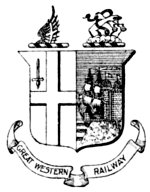
VOLUME TWO
Published in 1922 by
THE GREAT WESTERN RAILWAY
[FELIX J. C. POLE, GENERAL MANAGER]
PADDINGTON STATION, LONDON
CONTENTS AND ILLUSTRATIONS
This is a reprint in book form of the second series of The Line to Legend Land leaflets, together with a Supplement, "The Padstow May Day Songs."
The Map at the beginning provides a guide to the localities of the six Devon legends; that at the back to those of Cornwall.
Printed by Spottiswoode, Ballantyne & Company Limited,
One New Street Square, London, E.C.4
FOREWORD
The western parts of our country are richer in legend than any other part. Perhaps this is because of the Celtic love of poetry and symbolism inherent in the blood of the people of the West; perhaps because of inspiration drawn from the wild hills and bleak moors of the lands in which they live; perhaps because life is, and always was, quieter there, and people have more time to remember the tales of other days than in busier, more prosaic, districts.
Most of the Devon legends cluster around the grim wastes of Dartmoor, and, like that wonderful stretch of country, are wild and awe-inspiring. The devil and his wicked works enter largely into them, and there is reason to believe them to be among the oldest tales known to us. Possibly they were not new when the hut circles of the Moor were inhabited and Grimspound was a busy village.
Some of the Cornish stories told in this series, like the story of Lyonesse and of Parson Dodge and the Spectre Coach, have their beginning in historical fact; yet into the latter story has been woven a tale that is centuries older, in origin, than the days of the eccentric priest of Talland.
But old tales, like old wine, need nothing but themselves to advertise them. In their time they have entertained—who can say how many hearers through the ages? And they are still good—read or told—to amuse as many more.
LYONESSE
THE CHURCH THE DEVIL STOLE
Most travellers to the West know queer little Brent Tor, that isolated church-crowned peak that stands up defiantly a mile or two from Lydford, seeming, as it were, a sentry watching the West for grim Dartmoor that rises twice its height behind it. Burnt Tor, they say, was the old name of this peak, because, seen from a distance, the brave little mountain resembles a flame bursting upwards from the earth. Others—with less imagination and perhaps more knowledge—would have us believe that Brent Tor was once a volcano, and that it really did burn in ages long since.
But the old folk of the neighbourhood care less for the name of their Tor than for the strange story of the church that crowns its summit.
Ever so long ago, they will tell you, the good folk of the lower lands around the foot of the hill decided to build themselves a church. They had long needed one; so long that the Devil, who roamed about Dartmoor, had begun to consider that such an irreligious community was surely marked down for his own.
That is why, when he came upon the people one day setting to work to build a church, he was overcome with fury.
But he seems to have thought it all out carefully, and to have decided to let them go on for a while, and so, week after week, at the foot of Brent Tor, the little church grew.
At last it was finished, and the good folk were preparing great festivities for its dedication when, during one dark autumn night, the church disappeared.
In the greatest distress they bemoaned their sad plight, but they were quick to attribute the evil action to the Prince of Darkness, and to show him that they were not to be intimidated they decided to begin at once to build another church. Throughout the day they made their plans, and retired to rest that night determined to start on their pious work next morning.
But when they woke in the morning they saw with amazement their own church perched high on the hill above them. The Devil had stolen it, and to mock the villagers had replaced it on the hilltop, where, he thought, having dominion over the powers of the air, he would be able to defeat their designs.
The people, however, thought otherwise. They sent in haste for the nearest bishop, and with him proceeded to the top of Brent Tor. And, since St. Michael looks after hilltops, to him they dedicated their church.
Hardly had the service finished when the Devil, passing by, looked in to jeer, as he thought, at the foolish folk he had deceived. But on the summit of the Tor he met St. Michael.
The Archangel fell upon the Evil One and tumbled him straightway down the hill; then, to make sure of his discomfiture, hurled a huge rock after him. And there at the base of Brent Tor you may see the very rock to this day.
If you climb to the top of the hill you will get, on a fine day, one of the most beautiful views in the West. On one side is Dartmoor in all its rugged [7]glory; on the other, distant, blue and mysterious, the uplands of the Bodmin moors.
Lydford, from which you can best reach Brent Tor, is famous for its wild gorge. It stands on the edge of Dartmoor itself, and from it country of wonderful beauty may easily be reached. All around are hills and heather-carpeted moorland; yet a short railway journey will take you from this far-away village to busy Plymouth, Okehampton, or Launceston, the border town of Cornwall.
Here, where winds sweep from any direction across great wastes of moor, or from the sea, health and quiet are to be found more easily than in any popular holiday resort or fashionable spa.
THE PARSON AND THE CLERK
All real old stories of long ago should begin with "Once upon a time," and so, once upon a time there was a Bishop of Exeter who lay very ill at Dawlish, on the South Devon coast, and among those who visited him frequently was the parson of an inland parish who was ambitious enough to hope that, should the good bishop die, he would be chosen to fill his place.
This parson was a man of violent temper, and his continued visits to the sick man did not improve this, for his journey was a long and dreary one, and the bishop, he thought, took an unconscionable time in dying. But he had to maintain his reputation for piety, and so it happened that on a winter night he was riding towards Dawlish through the rain, guided, as was his custom, by his parish clerk.
That particular night the clerk had lost his way, and, long after he and his master should have been in comfortable quarters at Dawlish, they were wandering about on the high rough ground of Haldon, some distance from the village. At last, in anger, the parson turned upon his clerk and rebuked him violently. "You are useless," he said; "I would rather have the devil for a guide than you." The clerk mumbled some excuse, and presently the two came upon a peasant, mounted upon a moor pony, to whom they explained their plight.
The stranger at once offered to guide them, and very soon all three had reached the outskirts of the little coast town. Both parson and clerk were wet through, and when their guide, stopping by an old, tumble-down house, invited them to enter and take some refreshment, both eagerly agreed. They entered the house and found there a large company of wild-looking men engaged in drinking from heavy black-jacks, and singing loud choruses. The parson and his servant made their way to a quiet corner and enjoyed a good meal, then, feeling better, agreed to stay for a while and join their boisterous companions.
But they stayed for a very long while. The drink flowed freely and both grew uproarious, the parson singing songs with the best of the company and shouting the choruses louder than any. In this manner they spent the whole night, and it was not until dawn broke that the priest suggested moving onward. So none too soberly he called for the horses.
At this moment the news arrived that the bishop was dead. This excited the parson, who wished at once to get to work to further his ambitious designs, so he pushed the clerk into the saddle and hastily mounted himself. But the horses would not move. The parson, in a passion, cried, "I believe the devil is in the horses!"
"I believe he is," said the clerk thickly, and with that a roar of unearthly laughter broke out all around them. Then the now terrified men observed that their boisterous friends were dancing about in glee and each had turned into a leering demon. The house in which they had passed the night had completely disappeared, and the road in which they stood was transformed into the sea-shore, upon which huge waves were breaking, some already submerging the clerk.
With a wild cry of terror the parson lashed once more at his horse, but without avail. He felt himself growing stiff and dizzy—and then consciousness passed from him.
Neither he nor his clerk ever returned to their parish, but that morning the people of Dawlish saw two strange red rocks standing off the cliffs, and later, [11]learning this story, they realised that the demons had changed the evil priest and his man into these forms.
Time and weather have wrought many changes in the Parson and Clerk Rocks, not the least curious being to carve upon the Parson Rock the semblance of the two revellers. From certain positions you may see to-day the profiles of both men, the parson as it were in his pulpit, and the clerk at his desk beneath him.
The red cliffs around Dawlish make the place peculiarly attractive at first sight, and the attraction is not lessened by familiarity with the town. It enjoys the best of the famous South Devon climate; warm in winter and ever cooled by the sea breeze in summer, it is an excellent holiday centre. Historic Exeter is close at hand and Dartmoor within afternoon excursion distance.
THE WEAVER OF DEAN COMBE
About a mile outside Buckfastleigh, on the edge of Dartmoor, a little stream, the Dean Burn, comes tumbling down from the hills through a narrow valley of peculiar beauty. A short distance up this valley a waterfall drops into a deep hollow known as the "Hound's Pool." How this name arose is an old story.
According to the legend, hundreds of years ago, there was living in the neighbouring hamlet of Dean Combe a wealthy weaver named Knowles. He was famous throughout those parts of Devon for his skill and industry. But in due course he died and was buried.
On the day after the funeral, hearing a strange noise, Knowles' son ran to his father's work-room, where, to his alarm, he saw the dead man seated at his loom working away just as he had done day after day, year after year, in life. In terror the young man fled from the house, and sought the parson of Dean Prior.
The good priest was at first sceptical, but he returned with the frightened man to the house. As soon as the two had entered the door the parson's doubts vanished, for sure enough, from an upper chamber, came the familiar, unmistakable sound of the loom at work.
So the parson went to the foot of the staircase and shouted to the ghostly weaver: "Knowles, come down! This is no place for thee."
"In a minute, parson," came the reply; "just wait till I've worked out this shuttle."
"No," said the parson, "come thee at once; thou hast worked long enough on this earth."
So the spirit came down, and the parson led it outside the house. Then taking a handful of earth, which he had previously secured from the churchyard, he flung it into the ghost's face, and instantly the weaver turned into a black hound.
"Now, follow me," the parson commanded; the grim dog obediently came to heel. The pair then proceeded into the woods, which, so they say, as soon as the two entered, were shaken by a violent whirlwind. But at last the priest led his charge to the edge of the pool below the waterfall, then producing a walnut-shell with a hole in it, handed it to the hound and addressed it.
"Knowles," he began, "this shows me plainly that in life thou tookest more heed of worldly gain than of immortality, and thou didst bargain with the powers of evil. There is but one hope of rest for thee. When thou shalt have dipped out this pool with the shell I have given thee, thou shalt find peace, but not before. Go, work out thy salvation."
With a mournful howl that was heard as far as Widdicombe in the Moor, the hound leapt into the pool to begin its hopeless labour, and there, exactly at midnight or midday, they say, you may still see it at its task.
Buckfastleigh is on a branch line that runs up from Totnes, skirting Dartmoor, to Ashburton. All around is some of the most glorious scenery in Devon. Buckfast Abbey, founded in 1148 and for centuries a [15]ruin, was purchased by French Benedictines in 1882, and is now a live and busy monastery once again.
Just beyond Dean Combe is Dean Prior, a place of the greatest literary interest, for it was the home of the poet Herrick for many years.
The country all about abounds in objects of beauty and interest, yet is all too often neglected by the holiday-maker at the neighbouring seaside towns a few miles away, or the scurrying motorist speeding down along the Plymouth road.
THE DEMON WHO HELPED DRAKE
All the demons of whom the old folks tell in the West Country were not evil spirits. Some, like that one who helped Sir Francis Drake, worked good magic for the benefit of those to whom they attached themselves.
To Drake's demon a number of good deeds are attributed. One story they tell of him is of those days when the news of the fitting out of the mighty Spanish Armada had caused a thrill of apprehension to sweep through the country. The danger that threatened was very great, and Drake, like all of those who were charged with the safeguarding of our shores, was vastly worried, although he kept his worries to himself.
And one day, as the story goes, the great admiral was sitting, weighed down with anxiety, making and remaking his plans, on Devil's Point, a promontory that runs out into Plymouth Sound. As he was thinking, almost unconsciously he began whittling a stick. How, he wondered, could he find enough ships to combat the enormous force the King of Spain was sending against him?
Looking up from his reverie, at length, across the Sound, he started in happy surprise, for floating quite close to the shore he saw a number of well-armed gunboats; each chip that he had cut from the stick having been so transformed by the magic of his friendly demon.
Later, when Drake had achieved his great victory over the Spaniards, Queen Elizabeth gave him [18]Buckland Abbey. When he took possession, the legend goes, there was great need for stables and outhouses, and building work was set in train at once.
After his first night there, one of Drake's servants was amazed to find how much building had been done, and, feeling that something unusual must be going on during the hours of darkness, he secreted himself in a tree at dusk the next evening to see what happened. There he fell asleep, but towards midnight he was awakened by the tramp of animals and the creaking of wheels. Looking down, he saw several ox teams approaching, each dragging a wagon filled with building materials and led by a weird spectre form.
As the first team passed by, the spectre, urging the weary beasts on, plucked from the earth the tree in which the servant was hiding, in order to beat them. The unfortunate servant was cast to the ground, and, picking himself up, ran in terror to the house.
His violent fall injured him seriously, and they say that the fright made him half-witted for the rest of his life. Still, he recovered sufficiently to tell others of what he had seen, and to explain the mystery of the miraculous speed with which Buckland Abbey's outbuildings were constructed.
Buckland Abbey lies between Plymouth and Tavistock, close to the banks of the pretty River Tavy. Drake built his house there on the site of a thirteenth-century abbey, some remains of which are still to be found.
Preserved in Buckland Abbey is Drake's Drum, the beating of which in time of national danger would, so they say, bring the great Elizabethan sailor back from his ocean grave by the Spanish Main to fight once more for his country.
Plymouth, the port with which Drake is so closely associated, is a town brimful of interest, magnificently situated on high ground overlooking the sea. From famous Plymouth Hoe, the scene of the historic game of bowls, a view of unequalled charm may be obtained. Out at sea, the Eddystone Lighthouse is seen, and east and west the rugged shores of the Sound, always alive with shipping, meet the eye.
And although Plymouth is over 226 miles from London, it is the first stopping-place of the famous Cornish Riviera Express, which leaves Paddington each week-morning at 10.30 and arrives at Plymouth only four hours and seven minutes later.
THE SAMSON OF TAVISTOCK
In the beautifully situated old town of Tavistock there lived, just over a thousand years ago, a man of huge stature and great strength named Ordulph, of whom some strange stories are told. Ordulph was the son of Orgar, the then Earl of Devon, who was the founder of Tavistock's wonderful old abbey. Some of Ordulph's huge bones may be seen to-day in a chest in Tavistock church, to which place they were taken when his gigantic coffin was discovered beneath the abbey ruins many years ago.
As the old stories go, Ordulph used at times to amuse himself by standing with one foot on either side of the River Tavy, having previously ordered his men to organise a great drive of wild beasts from the Dartmoor forests above the town. The animals he caused to be driven between his legs, while he, stooping down, would slay them with a small knife, striking their heads off into the running stream.
On one occasion, they say, he rode to Exeter with King Edward of the Saxons. When the two with their retinue arrived before the city and demanded admission, there was some delay in throwing open the gates.
This Ordulph took as an affront to the King, and, leaping from his enormous black charger, he approached the portcullis and with his hand tore the ponderous thing from its sockets and broke it into small pieces.
Then, striding up to the strong iron-bound gates, with a kick he burst open bolts and bars, and proceeded [22]to lift the gates from their hinges. After that, with his shoulder he pushed down a considerable portion of the city walls, then strode across the ruins he had made into the now terrified city, and bade the alarmed townsfolk to be more careful next time to receive their King properly, lest worse things should happen to them.
King Edward, they say, was as much concerned as the citizens of Exeter about this stupendous exhibition of strength displayed by his companion. He was fearful at first that so violent a man must be in league with the devil; but apparently he was satisfied that this was not the case, for Ordulph lived a very pious life in his latter years, and contributed large sums to the endowment of the abbey his father had founded.
Tavistock still retains many remains of its once mighty abbey. The town, situated as it is in a picturesque valley through which the beautiful Tavy rushes, crystal clear, from the moors, is one of the most attractive in all Devon. It is the finest centre for exploring the western part of Dartmoor, for the moorland creeps down to within a short walking distance of the town itself.
Fine fishing may be had in the neighbouring streams, there is a good golf course, and the country all around abounds in objects of great natural beauty and historic interest.
Exeter, the cathedral city which was the scene of Ordulph's Samson-like feat, is thirty-three miles away by a road that crosses the very heart of Dartmoor, a wild, beautiful highway that rises in places to [23]well over 1,200 feet; and sixteen-and-a-half miles to the south is Plymouth, from which Tavistock is easily reached by train.
There are few places in the West Country more attractive than this old town in the moors, so richly endowed by time and by nature.
THE MIDNIGHT HUNTER OF THE MOOR
Running across the southern part of the heart of wild Dartmoor is a very ancient road. "The Abbot's Way" they call it, and antiquaries hold varied opinions as to when it was made, and even as to where it led to and from. To-day, much of this old trackway has gone back to nature and cannot be distinguished from the rugged moorland across which it passes, but some [25]stretches of it survive in a strange green path marked here and there by a boundary stone or a much-weathered Celtic cross.
But the old stories—tales perhaps even older than the road—tell that the Abbot's Way is the favourite hunting ground of the Wish Hounds or Yell Hounds, an eerie spectre-pack that hunts across the wildest parts of the moor on moonless nights.
Strange, gruesome tales are told by those who, benighted or lost in the fog, have stumbled home through the dark of a winter night across the grim moorland. They tell—half dazed with fear—as they reach at last some house and welcome human companionship, of the wild baying of the hounds that drifted through the murk night to their ears, or of the sudden vision of the pack passing at whirlwind speed across bog and marsh urged onward by a grim black figure astride a giant dark horse from whose smoking nostrils came flame and fire.
The description of this figure, "The Midnight Hunter of the Moor," seldom varies, although stories of the Wish Hounds differ from time to time.
Some say that they are headless, and that their blood-curdling cries seem to emerge from a phosphorescent glow of evil smoke that hovers about the place where the head should be. Others describe them as gaunt, dark beasts with huge white fangs and lolling red tongues.
Up on the grim wild moors it is not hard at midnight, through the roaring of the wind, or in the stillness of a calm night broken only by the weird cry [26]of some nocturnal bird or the distant sound of a rushing stream, to imagine, far away, the baying of this spectre-pack.
The old country folk hold that the man or beast who hears the devilish music of the Wish Hounds will surely die within the year, and that any unhappy mortal that stands in the way of the hunt will be pursued until dawn, and if caught will inevitably lose his soul; for the dark huntsman, they say, is the devil, whose power is great over that rugged country between sunset and sunrise.
Even to-day some of the older people will tell you stories of escapes they have had from the Midnight Hunter, or of the fate that befell some friend or neighbour very many years ago who never returned from a night journey across the moor.
But grim as it may be after nightfall, the country which the Abbot's Way traverses is one of amazing beauty. You may pick up this old track on the moors a mile or two from Princetown, or strike north to join it from South Brent or Ivybridge station. To the west there is a stretch of it clearly marked near Sheepstor where it crosses the head-waters of the Plym.
Some think the old Way got its name because it was the means of communication between the Abbeys of Buckfast on one side of the moor and Tavistock on the other. Others say it was an old wool-trading track to the west.
Dartmoor all around this district is at its best. It is a riot of rugged boulder, fern, and heather, through which rushing streams, full of trout, flow swiftly [27]southward to the Channel. The Tors here are not the highest of the moor, yet many of them rise well above the 1,500 feet level.
It is a country easy of access, for the Great Western main line skirts the southern edge of Dartmoor between Totnes and Plymouth, and railway and coaching services enable the tourist to visit some of the most remote parts of the moor in a day trip from Torquay, Dartmouth, Teignmouth, or in fact any of the South Devon seaside resorts between Dawlish and Plymouth. But the visitor who wishes to explore Southern Dartmoor at leisure will find Newton Abbot the most convenient centre.
THE LOST LAND OF LYONESSE
There is a lot of truth mingled with the old legends that tell of the lost land of Lyonesse, a fertile and prosperous country that once extended west from Cornwall as far as the Scillies. According to those old traditions a vast number of villages and 140 churches were overwhelmed on that day, over eight hundred years ago, when the angry sea broke in and drowned fertile Lyonesse, and now, as an old rhyme has it:
"Beneath Land's End and Scilly rocks
Sunk lies a town that Ocean mocks."
On that fatal day, November 11, 1099, a mighty storm raged all about our coasts, but the gale was of unparalleled severity in the West. Those who have seen a winter gale blowing across the sea that now flows above the Lost Land will know that it is very easy to believe that those giant angry waves could break down any poor construction of man's hand intended to keep the wild waters in check.
For Lyonesse, they say, was stolen by the sea gradually. Here a bit and there a bit would be submerged after some winter storm, until came this grim November night, when the sea made a clean sweep of the country and rushed, with stupendous speed, across the flat wooded lands until it was brought to a halt by the massive cliffs of what is now the Land's End peninsula.
There was a Trevilian, an ancestor of the old Cornish family of that name, who only just escaped with his life from this deluge. He had foreseen what was coming and had removed his farm stock and his [30]family from his Lyonesse estate, and was making one further journey to his threatened home when the sea broke in upon it. Trevilian, mounted on his fleetest horse, just beat the waves, and there is a cave near Perranuthnoe which, they say, was the place of refuge to which the sturdy horse managed to drag his master through the angry waters.
There used to be another memorial of this great inundation at Sennen Cove, near the Land's End, where for centuries stood an ancient chapel which it was said a Lord of Goonhilly erected as a thanksgiving for his escape from the flood that drowned Lyonesse.
To-day all that is left of the lost land are the beautiful Scilly Islands and the cluster of rocks between the Scillies and Land's End, known as the Seven Stones. These rocks are probably the last genuine bit of old Lyonesse, for their Cornish name is Lethowsow, which was what the old Cornish called Lyonesse. Even now the local fishermen refer to the Seven Stones as "The City," for tradition tells that there was situated the principal town of the drowned land, and stories are told of how on calm days ruined buildings may be discerned beneath the waters near Lethowsow, and that in times past fishing-nets have brought up old weathered domestic utensils from the sea bottom near at hand.
A lightship now marks the Seven Stones, and at low water on a rough day the sight of the huge breakers dashing themselves into foam upon the rocks is an awe-inspiring one.
The Scillies lie twenty-seven miles west of Land's End and are reached by a regular service of steamers from Penzance. The journey across is fascinating, and magnificent views of the rugged coast are to be obtained.
And the Islands themselves provide a perfect place for a lazy holiday. A winter climate they seldom know; flowers bloom right through the year, and sea fishing and boating there are ideal. The Scillies consist of a group of about forty granite islands, only a few of which are inhabited. Many of the islets are joined together by bars of sand at low tide.
Though in the Scillies you may feel very far away from the great world, quaint, fascinating Penzance, from which you start, is very near—in time—from London. It is only six and a-half hours from Paddington, although over 300 miles have to be traversed in the rail journey.
THE PISKIE'S FUNERAL
The sand-hills that abound near the church of Lelant, by St. Ives, are now famous the world over for providing one of the most excellent golf courses in this country. But in the far-away simpler days, before golf had come south, and when Cornwall was a distant land seldom visited by strangers, the Lelant sand-hills had a different fame.
In those days they used to say that they were the favourite meeting-place of the piskies, or, as folks from other parts of England would call them, fairies. Strange stories were told by the people of Lelant of the moonlight revels indulged in by the small folk in sheltered corners of that great stretch of sand-dunes that borders the Hayle river.
One of the strangest stories is that of a piskie funeral, seen with his own eyes by a respectable villager ever so many years ago.
Old Richard, who witnessed this amazing sight, was returning late one night from St. Ives, whither he had been in search of fish. As he ascended the hill towards his home, he thought he heard the bell of Lelant church tolling. This struck him as being curious, for it was just midnight, so he went out of his way to have a look at the church, in case anything was wrong.
Arriving in sight of the building, he saw faint lights within; and still the bell continued to toll, though, as he noticed then, in a strange way, with a queer muffled sound that aroused no echo.
Richard then crept forward to see what was happening. Peering cautiously through one of the windows, he was at first unable to distinguish anything, although a strange light illuminated the whole church. But after a few moments he was able to discern a funeral procession moving slowly up the centre aisle. It consisted of the little people, crowds of whom filled the church. Each piskie looked very sad, [34]although, instead of being dressed in mourning, each carried a gay wreath or garland of roses or myrtle.
Presently the watcher beheld a bier borne by six piskies, and on it was the body—no bigger than a small doll, he said—of a beautiful lady. The mournful procession moved forward to the sanctuary, where Richard observed two tiny figures digging a wee grave quite close to the altar table. When they had completed their task, the whole company crowded around while the pale, lovely corpse was gently lowered into the earth.
At this moment all the piskies burst into the saddest notes of lamentation, tearing their wreaths and garlands asunder and casting the flowers into the grave. Then one of the midget grave-diggers threw in a shovelful of earth and the most piteous cry of sorrow went up from the small folk, who wailed, "Our Queen is dead! Our Queen is dead!"
Old Richard was so much affected by this that he joined in the cry of lamentation. But no sooner was his voice heard than all the lights were extinguished and the piskies fled in consternation in every direction. Richard himself was so much alarmed that he ran for his home, firmly convinced that he was fortunate to have escaped with his life.
Lelant Church and the sand-hills remain to-day much as they were on that long-ago midnight when Richard attended the piskie's funeral, but nowadays the country round about has become one of the most favoured, by visitors, in all Cornwall.
Lelant with its golf course, pretty Carbis Bay with [35]its wonderful bathing beach, and St. Ives, beloved of artists and those in search of rest and health, a few miles further on, are all places that exercise the strongest fascination for those who have once visited them. The district is singularly attractive to the tourist; wild, rugged coast or grim moorland scenery is to be found within easy walking distance, while nestling in between the forbidding cliffs are pleasant sheltered sandy coves where one may bathe in safety or laze away the sunny hours, protected from the harsher winds that sweep the uplands.
Large modern hotels are to be found at St. Ives and Carbis Bay, and the sailing and sea-fishing of the Hayle Estuary are as good as any in all that favoured land of Cornwall.
THE SPECTRE COACH
In the days of Good Queen Anne, the parson of Talland, a quaint little sea-girt village near Looe, was a singular man named Dodge. Parson Dodge's reputation in that neighbourhood was that of being able to lay ghosts and command evil spirits, and although the country folk were rather terrified of their vicar, they had the utmost faith in his marvellous powers.
And it happened that the good folk of Lanreath, a few miles away, were suffering severely from a wild spirit that frequented the high moor in their parish. The ghost was that, they said, of an avaricious landowner who had wasted his fortune in lawsuits, attempting unjustly to seize from the villagers a wide stretch of common-land. Disappointment had killed him, but in the spirit world he could find no rest, for he used to return of nights to the land he had coveted, and drive wildly about in a black coach drawn by six sable, headless horses, much to the terror of the country folk.
So the rector of Lanreath decided at last to appeal to Parson Dodge to come over and exorcise the wandering spirit. Parson Dodge agreed, and upon the appointed night he and the rector rode out on to the haunted moor to see what could be done about the bad business.
It was a grim, barren spot that they reached at last and the rector did not at all like his task. But Parson Dodge bade him cheer up, saying that he never yet met the ghost that he couldn't best. So the two parsons dismounted and tramped up and down for an hour, expecting every moment the arrival of the spectre coach.
When at last midnight had passed and nothing had happened, they decided to abandon their vigil and return some other night. So, taking leave of one another, they separated, the rector to take a short ride to his home, Parson Dodge going a mile across the moor to the road that led him back to Talland vicarage.
Dodge had been riding about five minutes when, without any apparent reason, his mare shied, then stood stock-still. The parson tried to urge her on, but she refused; then he dismounted and tried to lead her, but that failed too. So he concluded that he must be intended to return, and, remounting, he set the mare off back to the haunted moor.
She went cross-country through the murky night like the wind, and in a very few minutes Dodge was again on the spot where he had left his brother priest. There the mare shied once more and showed every sign of fear, and the parson, looking about him, espied a short distance off the gruesome spectre he had originally come to meet.
There was the sooty-black coach, the dark, headless steeds, and, what thoroughly alarmed him, a grim cloaked figure urging his team at a gallop along a path in which lay the prostrate form of his friend the rector of Lanreath.
Parson Dodge set his mare, despite her fears, straight for the approaching coach, uttering his prayers of exorcism the while. With the first words the dusky team swerved and a sepulchral voice came from the driver, saying: "Dodge is come! I must be gone." With that the spirit whipped up his horses and disappeared at a tremendous pace across the moor, and was never seen again.
The parson then dismounted and was able to revive the unconscious rector and carry him safely home, for his own horse, startled at the appearance of the spectre, had thrown its rider and bolted.
Talland, the home of the old parson, is a fascinating little village on the coast, between the two Looes—East and West—and picturesque Polperro, where rugged cliffs on either side descend to form a sheltered little bay.
Looe is a quaint fishing town straggling on each side of the estuary of the river of the same name. You reach it by a branch railway from Liskeard, on the Great Western main line. It is an ideal place in which to spend a quiet holiday. The coast east and west is typically Cornish, rugged and wild, yet pierced every few miles by some sheltered cove or inlet.
Looe itself, protected from the cold winds, enjoys a beautiful climate, particularly mild in winter. Coast and moorland walks abound; there is a golf course close at hand, and the sea fishing is excellent.
ST. NEOT, THE PIGMY SAINT
Of all the vast company of saints peculiar to Cornwall, St. Neot is surely the strangest, for he was, so the old traditions have it, a pigmy, perfectly formed, yet only fifteen inches in height. There are very many stories told of this tiny holy man, and most of them seem to show that he wielded a great power over all animals.
One of the prettiest stories is of the time when St. Neot presided over his abbey and there came one night thieves to the monastic farm and stole all the monks' plough oxen. The poor brothers had not the money to purchase other beasts, and seed-time was upon them with their fields yet unploughed. Ruin seemed certain until the good little abbot appealed to the wild beasts to come to their aid. And then, to the amazement of the monks, there came from the surrounding forests wild stags, who docilely offered their necks to the yoke and drew the heavy ploughs.
Each night the stags were released, and they went off to the woods; but each succeeding morning they returned to continue their task.
The news of this miraculous happening spread rapidly abroad and came at last to the ears of the thieves. They were so deeply impressed by the story that they returned the stolen oxen at once and promised never again to pursue their evil ways. So the stags were released from their self-appointed labour, but ever after, they say, each bore a white ring like a yoke about its neck, and each enjoyed a charmed life, for no arrow or spear of a hunter could hurt it.
Another story that is told is that of St. Neot and the hunted doe. While the good saint was seated in contemplation by his well, there burst from the woods a doe pursued by hounds and huntsmen. The poor beast was exhausted and sank down by the saint as if imploring his protection.
The tiny saint rose and faced the oncoming pack, which instantly turned and dashed back into the forest. Presently the huntsmen approached with drawn bows, prepared to dispatch the frightened quarry. But they too, at the sight of the saint, desisted, and the chief of them, falling upon his knees, cast away his quiver and besought the Holy Neot to receive him into the Church.
This man, they say, became a monk at the monastery of St. Petroc at Bodmin, and the hunting-horn which he carried on the day of his conversion was hung for many years in St. Neot's church.
Many of the stories of this saint are depicted in the mediæval stained-glass windows of the parish church of St. Neot, a pretty village nestling under the southern slopes of the Bodmin Moor. This church has one of the finest sets of fifteenth and sixteenth century painted windows in the country, which rival the famous Fairford glass in Gloucestershire.
St. Neot is easily reached by road from Bodmin or Liskeard, or from Doublebois station, on the main line, from which it is distant about three miles. The village lies in a sheltered valley surrounded by charming wooded country, and from it you may [43]reach, only a short distance away, the edge of wild Bodmin Moor itself.
Bodmin, an attractive yet—by the tourist—much neglected town, is some seven miles away. Bodmin, the capital of Cornwall, is a quiet, sleepy old town ideally situated as a centre from which to reach many parts of the Duchy. Midway between the two coasts, with a good rail service to either, and close to the wild moorland that bears its name, this town is rich in history.
The moor with its two Cornish mountains, Brown Willy and Rough Tor (which you must pronounce to rhyme with "plough"), is easily reached, and the rail will take you to Wadebridge or Padstow on the rugged north coast; or south to sheltered Fowey—the Troy Town of "Q"—for an afternoon's excursion.
THE OLD MAN OF CURY
They tell a story down in Meneage, as the southernmost corner of England—the Lizard peninsula—is called, of an old man from the little village of Cury, near Mullion, who once rescued a mermaid who was stranded by the receding tide, and could not get back to her husband and family, who were awaiting her in a cave by Kynance Cove.
The old man was walking along the shore one summer evening, thinking of nothing in particular, when he saw, in a deep pool left by the falling tide, a beautiful lady with long golden hair who appeared to be in the greatest distress.
When he drew nearer to her and discovered that she was a mermaid he was filled with alarm, for he had heard many tales of these sea sirens from the fishermen of Gunwalloe. He was for running off home as hard as he could, but the piteous cries of the lovely creature were too much for his kind heart, and he went forward to enquire what her trouble might be.
At first, she was too terrified to reply, but the old man managed to pacify her and she sobbed out her story. While her husband and children were asleep in the cave, she said, she had been attracted by the scent of the glorious flowers, which grow all about the Lizard, and to get as close to them as possible she had drifted in on the waves, and, revelling in the sweet perfume, had not noticed the falling tide until she discovered herself cut off in the rock pool.
Now, she explained, if her husband awoke and [46]found her missing he would grow terribly angry, for she was supposed to be hunting food for his dinner, and if none arrived he would as likely as not eat the children.
The old man, horrified at this terrible possibility, asked what he could do to help. The mermaid replied that if he would only carry her back to the sea, she would give him any three things he cared to ask. He at once offered to undertake the task, and asked, not for wealth, but that he might be able to charm away sickness, to break the spells of witchcraft, and to discover thieves and restore stolen property. The mermaid readily agreed to give him these powers, but she said he must come to a certain rock on another day in order to be instructed as to how to obtain them. So the old man bent down and, the mermaid clasping him round the neck with her beautiful arms, he managed to carry her on his back to the open sea.
A few days later he went to the rock agreed upon and was met by the mermaid, who thanked him heartily for his aid, and fulfilled her promise by telling him how he could secure the powers he desired. Then, taking her comb from her golden hair, she gave it to him, saying that so long as he preserved it she would come to him whenever he wanted her; and with that, and a languishing smile, she slid off the rock and disappeared.
They say that the old man and she met several times afterwards, and that once she persuaded him to carry her to a quiet place where she could watch [47]human beings walking about with their "split tails," as she described legs. And if you doubt this story, the old people along the coast will still point out to you the "Mermaid's Rock" to prove you wrong.
All around the Lizard the wild coast is indented with beautiful little coves whose pure sandy beaches are washed twice each day by the incoming tide. In the deep sheltered valleys of Meneage flowers grow in profusion, while on the bold high moorland of the interior that rare British plant the Cornish heath flourishes in great bush-like clumps.
You reach this wonderful country by the Great Western road-coach service from Helston. Mullion, Kynance, Cadgwith, St. Keverne, all in this district, are places of amazing beauty and charm. There are big modern hotels to be found at Mullion, and there are golf and sea fishing, bathing, and entrancing walks by sea or moor to amuse the visitor in this warm, sea-girt land of heath and flowers.
THE HOOTING CARN
One of the grimmest yet most fascinating tracts of moorland in the West is that wild, boulder-strewn district behind St. Just in Penwith, near the Land's End. Here, amid a scene of savage beauty, wind-swept by the great gales from the Atlantic, is a stretch of treeless moor the richest in all Cornwall in remains of prehistoric man.
There is something eerie about this furthest west corner of England and around it cluster legends galore. One of the queerest is that of the Hooting Carn, a bleak hill between St. Just and Morvah.
Cam Kenidzhek is its real name, but they are taking now to spelling it as it is pronounced—Carn Kenidjack. From it weird moaning sounds arise at night, and the strangely named Gump, a level track just below the summit, was, they say, the scene of a grim midnight struggle in the very old days.
It happened that one moonless night two miners, walking back to their homes from Morvah, passed by the base of the Hooting Carn. They knew its ill repute and hurried along in silence, their fears not allayed by the fact that on this night the moaning of the Carn was more persistent than usual, and that an unearthly light seemed to illuminate the rocks on its summit. Presently, to their great alarm, there sounded behind them the thunder of galloping hoofs. Turning in fear, they saw a dark-robed figure, with a hood covering his face, approaching. As he dashed past, he signed to them to follow, and, as they explained later, some irresistible force made them obey. Without knowing how they did so, they were able to keep pace with the galloping steed and arrived swiftly near the top of the hill.
There the dark horseman dismounted, and the miners, terrified, found that they had been brought into the midst of a wild company of men of huge size, with long, unkempt hair and beards, their faces daubed with bright colours, and all engaged at the [50]moment in singing a reckless chorus which concluded in an uncanny hooting sound. But the arrival of the dark rider brought the demoniac singing to an end. A circle was quickly formed, and two men, more huge and more terrible than any present, were brought forward to contest in a wrestling match. The horseman, squatting on the ground, gave the signal to begin, but after a few preliminary moves the wrestlers complained that the light was insufficient. Then the squatting demon—for such he proved to be—flashed from his eyes two great beams of fire that lit the whole ring.
The struggle then proceeded, amid the wild yells of the onlookers. At last one of the wrestlers lifted his opponent clear off his feet, and hurled him to the ground with stupendous force. There was a sound like thunder as he fell, and he lay as one dead. At once the whole ring broke into confusion and crowded round the victor. This seemed to the miners grossly unfair play, and they went over to the fallen man to give him what aid they could.
They found him in a terrible state, and, since no aid was available, one of them started to offer up a prayer for the dying man's soul.
With his first words the utmost consternation fell upon the company. A great clap of thunder shook the rocks, a pitchy darkness covered the scene, and a fierce wind swept the hill. Then, looking upward, the miners saw the whole company—the dying man with them—disappearing northward in a dense black cloud, the two blazing eyes of the demon who [51]had led them to the Carn being clearly distinguishable for some time.
Paralysed with fear, the miners remained where they were, until returning daylight broke the evil spell and permitted them to proceed to their homes and explain to their neighbours the secret of the Hooting Carn.
Carn Kenidjack you may reach by a glorious tramp across the moors from St. Just, to which a Great Western motor-coach goes many times daily from Penzance. From the higher ground you will get magnificent coast views, embracing, on a clear day, the distant land of the Scillies.
All about the moor you will find the strange relics of a former race: stone circles, barrows, cromlechs, and prehistoric dwellings mingling with the fern and heather and stunted grass of the hillside, and you breathe in tonic air that has come to you across two thousand miles of ocean.
PADSTOW AND ITS MAY DAY SONGS
May Day in Padstow, on the north Cornish coast, is celebrated by an ancient custom of peculiar interest. The whole town is en fete, the ships in the harbour decked with flags, the people adorned with flowers. The feature of the day's celebrations is the Hobby Horse Dance, or procession, to two very old tunes. Until comparatively recent times the Maypole was still erected each year in the town.
Padstow's two old May songs date from the Middle Ages, but they have suffered much corruption in the course of time. Words and music have been altered, but the version given here is from an old source, and, owing to the irregularity of the metre of the lines, as in all traditional songs, a considerable amount of ingenuity is called for on the part of the singer to fit the words of the second and subsequent verses—particularly of the Day Song—to the tune. But it can be done.
The May Morning Song has eighteen or more verses—each followed by the chorus—all of which obviously cannot be printed here. There are a dozen that begin "Rise up...," the name of the person before whose house it is being sung being inserted.
The reference to "Un Ursula Bird" in the second verse of the Day Song has a traditional reference to an old dame who, it is said, led a party of Cornish women in red cloaks, headed by the Hobby Horse, in procession round the cliffs in days gone by and so frightened away a hostile French ship, whose captain mistook the women for soldiers. A similar story is told of Fishguard in South Wales in Legend Land Leaflet No. 11.
(Listen to MIDI version of the above)
Sheet Music: Page 1, Page 2.
With the merry singing and the joyful spring,
For summer is a-come in to-day,
How happy are those little birds that merrily doth sing
In the merry morning of May!
Chorus: Unite! all unite! &c, after each verse.
Young men and maidens, I warn you every one,
For summer is a-come in to-day,
To go unto the green woods and bring the may home
In the merry morning of May!
Rise up, Mr ——, with your sword by your side,
For summer is a-come in to-day,
Your steed is in the stable and waiting for to ride
In the merry morning of May!
Rise up, Mr ——, and gold be your ring,
For summer is a-come in to-day,
And send us out a cup of ale, and better we shall sing,
In the merry morning of May!
Rise up, Mrs ——, all in your gown of green,
For summer is a-come in to-day;
You are so fair a lady as waits upon the queen,
In the merry morning of May!
Rise up, Mr ——, I know you well a fine,
For summer is a-come in to-day;
You have a shilling in your purse, but I wish it was in mine,
In the merry morning of May!
Rise up, Miss ——, and strew all your flowers,
For summer is a-come in to-day;
It is but a while ago since we have strewed ours,
In the merry morning of May!
Rise up, Miss ——, and reach to me your hand
For summer is a-come in to-day;
You are so fair a damsel as any in the land,
In the merry morning of May!
Rise up Master ——, and reach to me your hand,
For summer is a-come in to day;
And you shall have a lively lass, and a thousand pounds in hand,
In the merry morning of May!
Where are the maidens that here now should sing?
For summer is a-come in to day,
Oh, they are in the meadows the flowers gathering,
In the merry morning of May!
The young maids of Padstow, they might if they would—
For summer is a-come in to day—
They might have a garland, and decked it all in gold,
In the merry morning of May!
Where are the young men that here now should dance?
For summer is a-come in to day;
Oh some they are in England, and some they are in France,
In the merry morning of May!
The young men of Padstow, they might if they would—
For summer is a-come in to-day—
They might have built a ship, and gilt her all in gold,
In the merry morning of May!
Now fare ye well, we bid you all good cheer,
For summer is a-come in to-day,
We'll call once more unto your house before another year,
In the merry morning of May!
(Listen to MIDI version of the above)
Sheet Music: Page 1.
Up flies the kite,
And down falls the lark, O!
Un Ursula Bird she had an old ewe, O!
And she died in Old Park O!
Oh, where is St. George?
Oh where is he, O?
He's down in his long boat,
All on the salt sea, O!
Oh, where are those French dogs?
Oh, where are they, O?
They're down in their long boats,
All on the salt sea, O!
Oh, where are those French dogs?
Oh where are they, O!
They shall eat the grey goose feathers,
And we will eat the roast, O!
The last verse of the Morning Song is sung to its own tune to conclude the Day Song.
Padstow itself is a queer old fishing town, fifteen miles from Bodmin, from which place it is easily reached by train. It is situated at the mouth of the Camel, the finest salmon river in Cornwall, and has at St. Enodoc, on the other side of the estuary, one of the best golf courses in England.
LEGEND LAND
![[An illustration showing fairies tending a garden.]](https://www.gutenberg.org/cache/epub/67175/images/i28.jpg)
Being a further collection of some of the Old Tales told in those Western Parts of Britain served by the Great Western Railway
Volume Three Price Sixpence
LEGEND LAND
Being a further collection of some of the OLD TALES told in those Western Parts of Britain served by the GREAT WESTERN RAILWAY, now retold by LYONESSE
![[An illustration showing the shield of the Great Western Railway.]](https://www.gutenberg.org/cache/epub/67175/images/i01.jpg)
VOLUME THREE
Published in 1923 by
THE GREAT WESTERN RAILWAY
[FELIX J. C. POLE, GENERAL MANAGER]
PADDINGTON STATION, LONDON
CONTENTS AND ILLUSTRATIONS
![[**** Deocrative divider ****]](https://www.gutenberg.org/cache/epub/67175/images/dec-div.png)
This is a reprint in book form of the third series of The Line to Legend Land leaflets, together with a Supplement, “John Dory,” an old Cornish “Three Man’s” Song.
The Map at the beginning provides a guide to the localities of the six Welsh legends, that at the back to those of Cornwall and “John Dory.”
![[**** Decorative divider ****]](https://www.gutenberg.org/cache/epub/67175/images/dec-div.png)
Printed by Kelly & Kelly,
Moor Lane, London, E.C.2.
FOREWORD

his third volume of Legend Land tells some more of the old stories of those peoples, kindred in origin, the Welsh and the Cornish. They are mostly the old tales that have survived—who shall say how many generations?
If you look into them, with the eyes of imagination, you will see behind them the simplest romances of a very simple people; a people that explained some uncomprehended thing with some comprehensible story, or who would invest the memories of their great men and women with records of wonderful achievement often formerly attributed to some yet earlier hero.
But that is a student’s occupation. Many weighty tomes have been written upon the origins of folk-lore.
For us it is sufficient to be glad that the old legends have survived. Let us enjoy them without speculation as to their beginnings, remembering only that they had a beginning, most of them in an age so long ago that history cannot place it.
These romances are perhaps the most “genuine antiques” that our country can offer, and they come from the corners of our land where romance still lingers and where, to the country folk, rocks and lakes, streams and great hills, are matters of history—not geology.
And we, who travel to these distant parts of Britain, can better enjoy their charms if we go there knowing something of the stories that have clung about them for many centuries, and if we leave our critical business method of mind behind us locked in our office desks.
That is why these old tales are again retold by
LYONESSE.
[Pg 4]
![[An illustration showing a Prince with gallows for a mouse being addressed by a bishop.]](https://www.gutenberg.org/cache/epub/67175/images/i04.jpg)
A PRINCE WHO WOULD HANG A MOUSE
[Pg 5]

n the very border line of “The Little England Beyond Wales,” as South Pembrokeshire is known, a land of many splendid old castles into which the sea bites deep at Milford Haven, stands Narberth Castle, famous for many things, among them that its owner once tried to hang a mouse.
It is a queer old story of magic and sorcery, and as the tale goes, far, far back in history, Prince Manawyddan lived at Narberth Castle with his stepson Pryderi and Cigfa his wife. One day a great darkness fell upon the land, and when it had passed Pryderi and all the retainers had vanished. Narberth was left unpeopled save for the Prince and Cigfa.
So these two fell to work to cultivate the land themselves. They worked hard and when harvest time came they were rewarded by the sight of many fields of waving corn. But, when they began to reap, Manawyddan and his daughter-in-law found to their consternation that the grain had been eaten from every ear of corn and that all they reaped was straw. The Prince suspected sorcery, and resolved to watch that night in an adjoining field which had not yet been robbed.
Towards midnight he heard a weird rustling sound, and, gazing from his place of concealment, he saw a horde of field mice roaming over his crops, nibbling away at the ears of wheat. Manawyddan sprang forward and captured one of the marauders, and the others scampered away.
For safety he placed the captured mouse in a glove[Pg 6] and then returned to Narberth Castle determined to hang the thief. He erected a little gallows, and was fashioning a noose of string in order to carry out the execution on the castle slopes, when there came along a scholar who enquired what the Prince was doing.
Manawyddan told him, and the scholar protested, saying that it was unseemly for a prince to act a hangman’s part. “Come, I will give you a pound to ransom the thief,” he added, but Manawyddan refused. So the scholar passed on and presently a priest approached. He too enquired as to the Prince’s task and also tried to dissuade him from it, offering five pounds as a ransom. But the Prince was adamant.
Then as he was about to release the mouse from his glove and string it up, a bishop came by. Like the other two strangers he began to argue with Manawyddan and offered ten, then twenty pounds to have the mouse set free. But the Prince’s suspicions were now aroused. “No,” said he, “the thief shall hang.” Then the bishop fell into a great rage and stamped his foot in anger, and as he did so his mitre fell off disclosing the fact that he was no bishop but a noted sorcerer of the neighbourhood.
“Name your price,” he said at last, “the mouse shall not hang, for she is my wife.”
So Manawyddan drove a bargain. He demanded the return of his stepson; that all spells should be removed from his land and never replaced; and that no vengeance should be wreaked upon him. To this the enchanter agreed, and the Prince untied his[Pg 7] glove and out ran, not a mouse but a beautiful lady who went away with her rescuer.
That night the stepson and all the retainers returned, the cornfields grew rich and ripe, and ever since Narberth and the lands round about have been amazingly fertile.
You may prove the truth of this latter to-day if you visit this pleasant and prosperous land, with its mild climate and abundant crops. There is a station at Narberth, but Tenby, that picturesque and attractive little town on the coast of Carmarthen Bay, is perhaps your best centre for the district. The coast to the westward is wild and rocky, while inland is a glorious country, scattered more thickly than any part of our islands with the remains of noble medieval castles.
Tenby itself is one of the most delightful seaside towns in the country. It has extensive sands between its rocks and the sea’s edge. The place has ample accommodation for visitors of all kinds, and the praises of Tenby’s reputation for sunshine at all seasons of the year have been sung by writers for many years past.
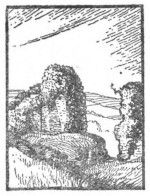
Narberth Castle.
[Pg 8]
![Illustration showing St. Melangell greeting a few men.]](https://www.gutenberg.org/cache/epub/67175/images/i08.jpg)
[Pg 9]
St. MELANGELL AND HER “LAMBS.”

p in the Montgomeryshire mountains, three or four miles from the shores of Lake Vyrnwy, is the little village of Melangell, named after a saint who for fifteen years, so the story goes, lived a lonely life in the midst of the wild hills, sleeping on the bare rock, rather than marry the man her father had designed for her.
St. Melangell was the daughter of a Welsh chieftain, and when she ran away, to avoid the undesirable bridegroom, she hid herself in a remote but lonely spot at the head of the Tanant. Every effort to make her return to her father’s home failed and she continued to live her secluded life, choosing the birds and the animals for friends.
After some fifteen years of this solitary existence, they say, Brochwel, Prince of Powis, was hare hunting up in the hills and ran his quarry into a dense thicket. He entered in pursuit and soon found himself face to face with a woman of marvellous beauty beneath whose robes the frightened hare had taken refuge.
This strange woman raised her hands in supplication, and begged the Prince and his party to depart and spare the life of the animal that had come to her for succour. It was one of her friends, she said. The Prince, much impressed by this incident, halted, unable at first to understand what was happening, but his attendant huntsman, ignoring the gentle plea and anxious only to be on with the chase, raised his horn to his lips to rally the hounds.
[Pg 10]
Then a strange thing happened. No sound issued from the horn, nor could he remove it from his mouth to which it remained stuck fast.
In terror, the man fell upon his knees, and tried to beg forgiveness, but he could not articulate. Then Prince Brochwel, realizing at once that he was in the presence of a very holy woman, stepped forward and asked her pardon, promising that the hare should receive no hurt from him. The holy woman smiled and the huntsman regained his speech, his horn dropping to the ground.
The Prince then asked Melangell what he could do to serve her. Melangell asked for a grant of a small piece of land to serve as a sanctuary. The Prince immediately gave her far more than she asked and besought her to found upon it a convent.
So the good woman proceeded to carry out his wishes and lived the rest of her holy life in a cell, which you may see to-day at the east end of Melangell Church. And upon the cornice of the oak screen of the church you will find carved many scenes from her life story.
St. Melangell ever retained her love for wild animals and is considered to have taken hares, which she called her “lambs,” under her particular protection. They say that even now, if you call upon St. Melangell to aid a hare pursued by hounds, the animal will escape; consequently, the holy woman is not greatly beloved of huntsmen.
Her lonely hill-side bed, upon which she slept for fifteen years, still survives near the church. It is a[Pg 11] recess in the rock now overgrown with bushes, but is there for all the world to see, to prove conclusively—if you require proof—the truth of this charming legend of the solitary lady of the hills.
Melangell and the lovely country of hill and stream, and glittering waterfalls, thickly wooded little valleys, and bare upstanding mountains, that stretches all about it, is best reached from Llandrillo Station on the picturesque line that runs from Corwen to Bala by the valley of the Dee. This is a fine sporting country, where the red grouse flourishes and where the streams and lakes hold trout in abundance. “The Welsh Highlands” it is aptly called.
The Berwyn Mountains, that here divide Merioneth and Montgomeryshire, rise to over 2,000 feet in Moel Ferna near Corwen, from which station there is a motor car service in summer to Bettws-y-Coed, a place, perhaps, more famed than any in Wales for the beauty of its surroundings.
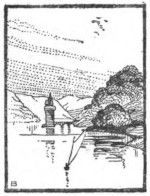
Lake Vyrnwy.
[Pg 12]
![[An illustration showing an old man pointing out a pile of gold to a younger man, while others sleep on the floor.]](https://www.gutenberg.org/cache/epub/67175/images/i12.jpg)
WHERE KING ARTHUR SLEEPS.

he old stories tell that King Arthur and his gallant knights are not dead; they are only sleeping and will awake with renewed vigour, should ever they be needed to fight the enemies of their beloved land. And their resting place is within the great upstanding limestone rock of Craig-y-Ddinas in South Wales.
There is a tale told of a Welshman from Llantrisant who was accosted on London Bridge, of all places, by a strange little man with a grey beard,[Pg 13] who asked where he had cut the hazel staff he carried. The Welshman replied: “In my own country not far from my home.”
“Where that staff was cut,” the grey beard said, “is gold beyond counting and I can show you how to get it.” So the Welshman invited his queer acquaintance to accompany him to his home, and shortly afterwards the two set out for Craig-y-Ddinas, which is a few miles away in the Vale of Neath.
They came to an entrance of a cave close by where the hazel staff had been cut, and the stranger bade the Welshman enter. Within the entrance was a silver bell hanging from the roof, beyond which a passage led to a great cavernous hall where, around a massive oak table, were a number of warriors, fast asleep, but still clad in their armour and with their weapons by their sides. One of these ancient warriors, with a long silver beard, wore a crown upon his head. This was the great King Arthur himself, the stranger said.
But what most attracted the eye of the Welshman was a mighty stack of gold piled high in the centre of the table, upon which the light from the flickering flames of a fire in one corner of the underground chamber glinted pleasantly.
“Now help yourself,” said the stranger, “but in carrying out your gold, do not ring the bell or you will awaken the knights. If you should chance to ring it be ready to answer immediately for they will ask: ‘Is it day?’ and you must reply: ‘Sleep on, it is still night.’ Then all may be well.” With this the mysterious stranger disappeared.
[Pg 14]
The Welshman did as he had been instructed, although in his hurry to escape with the treasure he did cause the bell to chime. But his answer satisfied the awakened warriors who instantly returned to their age-old slumbers.
For many years this Welshman lived in luxury and ease upon his stolen treasure, but at last it was exhausted, and he determined to go back again to the cave and seek some more. This time his greed tempted him to carry away more gold than he could easily lift. He staggered panting with his heavy burden to the entrance, and then again he blundered against the silver bell which gave out its warning notes.
The ancient warriors awakened. “Is it day?” they cried, but the Welshman was so breathless with his exertion that he could not reply. Then the knights rose from their chairs and fell upon him, beating him cruelly before they ejected him roughly from their cavern, and closed and locked the door behind him.
The greedy fellow lived for many years after this adventure but he never recovered from his trouncing and he died a cripple and a pauper in the town where he had lived in such opulence, and although he tried many times to find the treasure chamber again he could never do so. And so it is supposed that King Arthur and his knights still sleep on in Craig-y-Ddinas, awaiting the call to further action which may some day come.
[Pg 15]
Llantrisant, where the hero—or should it not be villain?—of this strange old story lived, is a charming little town straggling up the steep slopes of a wooded hill with—in this part of the world—the inevitable ruined castle close at hand. It is a forgotten little place in the midst of varied country with fine views from the top of the hill, over a moorland district towards the mountains of Brecknock.
Craig-y-Ddinas you will find in the beautiful Vale of Neath a little further west. It rises precipitously from the edge of the little river Mellte, and from its top, where the fairies dance of nights, you get a superb view of the lovely valley. Here you are in some of the grandest scenery in Wales, a country particularly rich in waterfalls and rushing brooks.
It is a lovely land skirted on the south by the Great Western Line, that runs from Neath to Aberdare. Neath, on the main line, is a good centre from which to start to explore this beautiful valley.
And when you tire of the mountains, you can turn southwards and see that stretch of little known coast, with its bold headlands and spring-turfed cliffs that runs from Briton Ferry as far as busy Barry Docks. Strangers do not often come here, yet in all our land it would be hard to find a more attractive district, made yet more pleasing by the absence of other holiday makers.
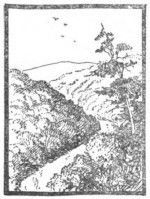
The Vale of Neath.
[Pg 16]
![[An illustration showing a woman sitting by window holding a bird and looking over her shoulder out the window.]](https://www.gutenberg.org/cache/epub/67175/images/i16.jpg)
[Pg 17]
BRONWEN AND THE STARLING.

his is the story of the sad fate that befell a sister of a British King who lived at Twr Bronwen, which stood where Harlech Castle now stands, and who married Matholwch, an Irish King, and sailed with him across the seas. Bronwen was her name, and they say that she was the most beautiful woman in all the land.
When Matholwch came across to Harlech to court her, he and Bronwen’s step-brother Evnyssien had a fierce quarrel, and so deeply insulted was the Irishman that the match was nearly broken off. However, Bronwen’s brother Bran, the King, managed to placate the angry suitor by giving him a staff of silver as tall as himself and a plate of purest gold as wide as his face, and presently the marriage was celebrated with greatest festivity, and the happy pair sailed away for Erin.
But though their King might forget this quarrel, wild subjects would not. They nursed a grievance against their new queen and stirred up so much trouble that at last Matholwch himself turned against his bride, putting slight after slight upon her, until in the end he degraded the beautiful princess to be cook in the palace where once she had reigned.
Bronwen tried to send word of her sad plight to her brother at Harlech, just across the Irish Sea, but the vengeful Irish circumvented all her efforts, destroyed her letters and killed her messengers.
At last, in despair, poor Bronwen hit upon a plan.[Pg 18] A Welsh starling, blown across the sea by an easterly gale, fluttered into her kitchen one day, and the Princess fed it and tended it, hiding it in the great kneading trough where she was forced to make bread for the whole household. When the bird recovered she wrote a letter to Bran, tied it to the starling’s leg, and released it.
The bird flew straight back to Harlech, but finding that King Bran was away at Carnarvon, followed him there, and perched upon his shoulder as he sat at dinner, ruffling its feathers and whistling loudly. Bran put up his hand to seize the bird to discover the cause of its amazing behaviour, and so found Bronwen’s letter.
The King fell into a mighty rage and ordered out his fleet, then sailed across to Ireland to rescue his sister and wreak vengeance upon her cruel husband. A great battle took place and Bran and his forces were eventually driven back, although they managed to rescue Bronwen. But King Bran was fatally wounded by a poisoned dart and died soon after he reached his Welsh home. Before he died, he commanded that his dead body should be taken to London and buried on the White Mount—upon which later the Tower of London was erected. Poor Bronwen, broken-hearted, survived her brother but a short time. She was buried at Ynys Bronwen in Anglesea, where, only a few hundred years ago when the mound tomb was opened, an urn was found containing the ashes of the unhappy princess.
This is a sad little story to centre around so[Pg 19] charming a place as Harlech, now dedicated, it seems, only to the happy laughter of contented holiday makers. Harlech stands upon the side of a castle-crowned hill, separated from the sea by those magnificent golf links famous throughout the world.
It is an ideal holiday resort in the midst of a district teeming with objects of natural beauty and antiquarian interest. From it, the railway line, which follows the greater part of the Cardigan Bay coast, gives easy access to such places as Barmouth, Aberystwyth, or northward to Criccieth and Pwllheli, while inland is a district of little lake-studded mountains and moorland, offering endless attractions to the walker, the artist, or the fisherman.

Harlech Castle.
[Pg 20]
![[An illustration showing a swan near the edge of a pond, with the head of a woman. The head is staring down into the water, perhaps mournfully.]](https://www.gutenberg.org/cache/epub/67175/images/i20.jpg)
THE SWAN OF GLASFRYN.

hat part of Carnarvonshire in North Wales that stretches out into the sea to Braich-y-Pwll, and forms the northern boundary of beautiful Cardigan Bay, is known as Lleyn. Lleyn is a peninsula of splendid scenery, both round the coast and inland by its mountains and moorland lakes; and almost every square mile of the place has its legend, or brave tale of historic times to tell.
[Pg 21]
Midway between its two coasts is the lonely little tarn of Glasfryn, about which a story is told reminiscent of that connected with Bala Lake which has been recorded in a previous story of Legend Land. Llyn Glasfryn, as the modern maps call it, was once Ffynnon Grassi, or Grace’s Well, which supplied water to those who lived by, and cultivated, the fertile fields now engulfed by the waters of the lake. Grace was a village girl whose task it was to tend this well, and one of her duties was to see that the cover which enclosed it was always kept closed when the well was not in use.
One day, so many years ago that nobody can rightly tell how long since it was, Grace neglected her duty. Some say that it was because of a mysterious and strikingly handsome youth who came down from Yr Eifl, the splendid mountain that rises nearly 2,000 feet into the sky, a couple of miles away. Others, that she was the victim of sorceries of a beautiful but evil enchantress from Anglesea. But anyhow the cover of the well was left open one night, and, as happened at Bala, soon after the weary country folk had retired to rest, they were aroused, in alarm, by a great flood which came from Ffynnon Grassi, which was pouring out a stream of water, that nobody could check.
Soon the prosperous farms and fertile lands round about were submerged beneath the waters, and Llyn Glasfryn was formed. But the careless Grace to whose negligence the great misfortune was due did not escape unpunished. She was turned into a[Pg 22] swan, and her fate was that, until the Day of Judgment, she must swim about the lake which her forgetfulness had caused to be created.
Some say that after many years she was forgiven, and died; but others hold that even to this day you may hear poor Grace’s piteous cries at the dark of night, as she swims her never ending course up and down the surface of Llyn Glasfryn. And if you chance to see this mournful bird you will find that its head is that of a beautiful maiden.
They also tell that beneath the surface of the lake lives a mysterious monster called “Old Morgan,” who, perhaps, is he who in those far away days beguiled Grace to forget her duty at the well. “Morgan” is a terrible person, with whom the country children round about are threatened when they misbehave.
This pathetic story of Grace and her sad fate is but one of the many that cling about Lleyn. March, the husband of the fair Iseult, had a castle here, and from that grim fortress, Iseult eloped with Tristan.
Near Yr Eifl, Vortigern fell a victim to the charms of the beautiful Rowenna, daughter of Hengest, and to win her favour agreed to assign Kent to her Anglo-Saxon father. Cromlechs and other remains of early man are to be found on nearly every hill side.
But you must visit this fascinating corner of Wales fully to appreciate its charm and romance. Criccieth or Pwllheli is a good centre. Each is an attractive little town by the sea facing due south and sheltered by mountains from the north or east winds.
[Pg 23]
Noble Snowdon, its summit over 3,500 above sea level, is not far away, and an excursion to the far end of Lleyn, where Bardsey Sound divides remote Bardsey Island from the mainland, takes the visitor through one of the most beautiful—and least known—districts in the whole of our country.
For the sportsman there is trout fishing in abundance here, and in season wild fowl shooting of a kind seldom known in more popular parts of the kingdom. For the artist there is the endless variety of rocky coast and mountain scenery, and for the average holiday-maker an unspoilt land swept by mild health-giving air, where he may idle away the days in perfect quietude and restfulness.
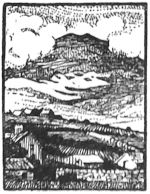
Yr Eifl.
[Pg 24]
![[An illustration showing a man with halo seeking refuge behind a large rock outcropping.]](https://www.gutenberg.org/cache/epub/67175/images/i24.jpg)
THE WONDERS OF ST. GOVAN’S CHAPEL.

n a ravine that cuts into the rugged cliffs by St. Govan’s Head on the south coast of Pembrokeshire, is a little chapel, once the hermitage of the saint whose name the headland bears. St. Govan was a disciple of St. David, and he had an adventurous life in this lonely part of Wales many hundreds of years ago.
The district was harried by pirates from the sea, and savage pagan tribesmen from the interior, and[Pg 25] the very rocks and stones of his sea-girt dwelling place had often to come to the rescue of the holy man. But though he has been dead these fifteen hundred years the rocks, they say, still work wonders for the visitor who goes to the little chapel with a believing mind.
It is a tiny little place, twenty feet by twelve, with a stone tower up which runs a staircase of over fifty steps. Exactly how many there are you must try to count for yourself, for it is said that they vary, and never number the same going up as they do coming down. Once fierce pirates landed here and stole a silver bell that hung in the chapel.
Poor St. Govan was forced to hide from these wretches on many occasions. A friendly rock would then come to his aid—you may see it to-day to the left of the altar in the chapel. This rock would open, when the saint was pursued and disclose a hollow within just big enough to enclose his form. Then it would shut and hold the holy man in security until the danger was passed.
After St. Govan died, the rock remained part open as it is now, and they say that it will adapt itself to the size of anybody, who really believes in its powers, who wishes to enter it. And if, when you are in St. Govan’s hiding place, you make a wish, and do not change your mind before you have turned round to come out again, you will surely obtain your desires.
For many years, so the story goes, there was close by the chapel a rock that gave out a beautifully[Pg 26] clear and musical note when struck. This rock, they said, contained the silver bell that the pirates stole, for these wicked men were not allowed to escape with their booty, for their ship was caught in a tremendous hurricane and swept on to the rocky shore, and all the miscreants were drowned.
But the stolen bell was saved by some miraculous power and carried to the rock, which became known as the “Bell-stone,” where it remained in security.
St. Govan’s holy well is situated a little below the chapel, and here cripples from all over Wales would travel to bathe in the healing waters which gave relief to their sufferings. There is another healing property in the cliffs near at hand, in the form of a deposit of red clay, which for centuries has had the reputation of curing sore eyes. But whether or not the earth and the waters around St. Govan’s Chapel will work their magic for you now, the winds that blow straight in from the Atlantic to this rockbound Pembroke coast will cure most ailments, and bring back health and renewed vigour to the most weary.
Pembroke is a good centre for this hilly land of castles. From here you may make excursions to some of the finest coast scenery in Wales, or crossing Milford Haven adventure into that beautiful and little known country that fringes the shore of St. Bride’s Bay.
Haverfordwest, a fascinating sleepy old town with three ancient churches, is a few miles on the other side of Milford Haven, which you cross in a steam[Pg 27] ferry; and from there a motor omnibus service will take you to far away little St. Davids, the “Cathedral Village,” with its wonderful Norman Cathedral Church. It is a magnificent journey that, from Haverfordwest to St. Davids, across a wild and windswept country with seventeen steep hills to negotiate in sixteen miles, and a magnificent view from the top of each one of them. And at the end of the road one of the choicest churches in the whole country, nestling in a sheltered valley, awaits you, and that sense of complete peace and quiet that can only be found in a place utterly remote from crowds, and the hustle and worry of modern life.
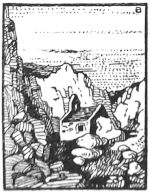
St. Govan’s Chapel.
[Pg 28]
![[An illustration showing fairies tending a garden.]](https://www.gutenberg.org/cache/epub/67175/images/i28.jpg)
THE FAIRY GARDENS OF TREEN.

he Small Folk, or Fairies, as strangers call them, are very fond of flowers. They have their own particular gardens in many places around the rough Cornish coast, but mostly they are to be found near the base of jagged cliffs in little green tracts, inaccessible either from the sea or from the summit of the cliff above. There are several of these near the foot of the cliffs round Trereen or Treen Castle, that rugged headland near the[Pg 29] Lands End, upon which stands the famous Logan Rock, or rocking stone.
You can generally tell a Small Folks’ garden by the many sea pinks that bloom there in season, and the peculiar brightness of the green of the ferns that nestle in the moist shade of the rocks. There is nothing much else to distinguish them by day, but of a summer night it is very different. Then if you chance upon one of them—which is very rarely—you will find the soft green of the cliff turf spangled with wee flowers of all colours, rare and beautiful, such as mere mortals never know.
And you may see the Little People dancing happily in rings around some sea pink which towers above their heads, or busying about with tiny water-pot or spade tending their beloved blooms.
The fishermen sometimes see them when, on a still summer night, their boats drift silently close in by the cliffs. They hear the strains of sweet soft music coming from close down by the water and see a constant moving of hundreds of tiny bright lights flickering in and out among the fairy flowers; and sometimes, on calm warm nights, the delicious scents of the flowers drifts far out to sea, a scent that is ten thousand times sweeter than any that came from a mortal garden.
Those who have been lucky enough to witness this wonderful scene say that you must be perfectly silent and hardly move, or you will frighten the Small Folk. They are very beautiful little creatures, seeking to harm nobody. They hold periodical feasts or[Pg 30] “Fairs,” as they are called, sometimes upon some lonely hill top, or in a glade in the depth of a thick wood. Then, when thousands of them are assembled together, their lights may often be seen for miles.
But you must not interfere with the Small Folk or they will punish you. They have their own ways of doing this. They will lead you astray for hours, or make you drop stitches at your knitting, or make you lose your path on a dark winter’s night. But to those who wish them well they will never do real harm and they seem often to be sorry for the mischief they have caused, and will reward their victims with some piece of good luck soon afterwards.
At least this is what the old people who have known the Little People will tell you, but they will not talk much about them nowadays for fear of not being believed.
Still you may see the Fairy Gardens for yourself by Trereen Castle if you will, and see all around some of the finest coast scenery in all Cornwall.
The Logan Rock itself is one of the sights of the country. It is a huge boulder of granite said to weigh 65 tons, so poised that without great effort it can be rocked to and fro. Once it was easier to move, but a mischievous naval officer pulled it from its base about 100 years ago. He was made by the Admiralty to replace it, but it has never rocked so freely again.
This is the westernmost corner of England, and a succession of magnificent headlands thrust themselves into the sea between Trereen and the Lands End. A few miles inland is Sennen, the “last” parish in the country.
[Pg 31]
Penzance is the best centre for visiting this remote district. A regular service of motor buses runs from that place to the Lands End, carrying the visitor within an easy walk of Treen Castle and its Fairy Gardens, and traversing on the way a wild windswept, almost treeless country, abounding in relics of our earliest ancestors—strange stone circles and British villages. The moorland hills here rise to 800 feet in height, and from them extensive views are to be had comprising, on ordinarily clear days, the far isles of Scilly, lying out in the Atlantic, thirty-five miles away.
This is a land of health and rest where Small Folks’ gardens seem far easier to understand than in the grime and turmoil of a great city.
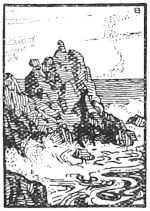
The Logan Rock.
[Pg 32]
![[An illustration showing one man has just pushed another man off the cliff.]](https://www.gutenberg.org/cache/epub/67175/images/i32.jpg)
HOW THE DODMAN WAS NAMED.

omewhere about the middle of the south coast of Cornwall, a noble headland, the Dodman Point, stretches abruptly into the Channel, towering, at its summit, 370 odd feet above the waves. It is one of the landmarks of the south coast well known to every sailorman.
Unimaginative people, like antiquaries and professors, will tell you that Dodman only means “Stone Point,” and is merely a corruption of the old[Pg 33] Cornish “Duadh Maen”; but the country folk take no heed of that; they know the old story handed down from long dead ages. They know that Dodman means “Deadman,” and this is why.
Ever so long ago there lived a giant in his castle on Dodman Point. The rugged earthworks, remains of the castle, are there to-day for you to see if you doubt it. This giant was the terror of the neighbourhood. He fed upon the best of the cattle and sheep, and very often children were missing, for the giant liked variety in his food.
The country people were powerless against this ogre whose size and strength were stupendous. To keep off intruders he dug, in one night, the great ditch—which is still there—that runs from sea to sea across the Point. But one stormy night he fell sick, and his howls of agony were heard for miles around, terrifying the simple peasant folk with their blood-curdling tones.
At last, towards midnight, there arrived at the village of St. Goran, a mile and a half inland, a messenger from the giant demanding the local doctor instantly, and threatening horrible revenge were he to delay. Now the local doctor was a very brave man, also he had suffered a good deal from the depredations of the evil giant, so he obeyed the summons and went back with the messenger, his neighbours never thinking to see him again.
Arrived at the castle, he found the giant rolling in agony on the ground, and he swiftly devised a plan for ridding Cornwall—and the world—of this horrible ogre.
[Pg 34]
“You must be bled,” he said, following the general medical treatment of the day.
The giant roared out that he would do anything to be rid of his pain. His voice was so loud, they say, that he could be heard distinctly at Mevagissey. So the doctor got to work and the treatment gave relief.
To complete a perfect cure, the doctor explained, the giant must sit on the edge of the cliff at the point of the headland, and the giant obeyed the instruction. And then the doctor, standing by and looking very wise and serious, allowed the monster’s blood to flow away until with weakness he became unconscious. The huge and hideous head sank lower and lower, the great powerful body crumpled, until at last the doctor, with a mighty effort, rolled his evil patient to the cliff’s edge—and kicked him off on to the rocks beneath.
Then he returned to tell the glad news to St. Goran, where, to celebrate it, they held a feast lasting five days. And ever after that the Giant’s promontory was known as the “Deadman,” or as we have come to call it, the “Dodman.”
There it is to-day as wild and beautiful a headland as any in Cornwall. In the giant’s mighty bulwark known locally as the “Hack and Cast,” wild flowers bloom. From the summit a wonderful view, from the Lizard to the west to the Devon coast eastward, extends.
Mevagissey, one of the most characteristic of Cornish fishing ports, is less than four miles away, and all[Pg 35] about is a fascinating little known country of deep fertile little valleys and seldom-visited villages, while the coast scenery of Mevagissey and Veryan Bays, which the Dodman practically divides, is rugged and charming.
Here you get the full freshness of the Atlantic breezes, fierce enough at times, but more often soft and soothing.
St. Austell is your nearest railway station, an interesting old town, the centre of Cornwall’s china clay industry. It is on the main line and may be reached easily from any part of south or west Cornwall, and from there country omnibuses will take you within a few miles of the remote Dodman, the scene of that village doctor’s wonderful “cure,” so many centuries ago.
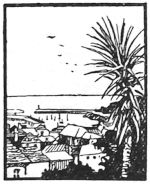
Mevagissey.
[Pg 36]
![[An illustration showing two mermaids, various fish and sea birds staring at a castle near the seaside with a flock of birds near it.]](https://www.gutenberg.org/cache/epub/67175/images/i36.jpg)
THE CHARMER OF PENGERSICK.

he Pengersick Castle that you find to-day, built by the coast between Parran Uthnoe and Porthleven near Helston, is a mere upstart building, little, if any of it, more than four centuries old. This story is about the older castle built on the same site nobody knows how long ago.
It was a grim fortress inhabited by grim and eerie folk, about whom many wild and creepy tales are told. The old Pengersicks were a strange family[Pg 37] who trafficked with the powers of evil. One went to far eastern climes and learned the black arts of sorcery, and brought back with him as his bride an “outlandish Saracen” woman of surprising beauty.
Nobody knew actually where she came from, but she arrived unexpectedly at the castle, one winter day, with her Lord and two eastern attendants, all mounted on priceless Arab horses. They spoke in an unknown tongue and disappeared behind the frowning gates, seldom to be seen abroad again.
Some say that this strange party arrived before the castle was built, and that it was this saturnine Lord of Pengersick who, by supernatural aid, erected the first grim fortress; but all agree that the beautiful Eastern lady possessed the most wonderful voice that had ever been heard.
No living creature could resist its appeal. Men and women, birds, animals, even fishes, stopped spellbound to listen when she sang. And she and she only could control her evil husband.
When engaged in his blackest sorceries, brewing strange potions that sent their exotic aromas throughout the country for miles around, or when, in the middle of a storm, he sat upon the battlements of his castle conjuring the Prince of Darkness, the Lord of Pengersick could always be quieted by the sound of his Lady’s voice singing her strange Eastern songs to the strain of her harp.
She seemed a sad, beautiful Lady, this Saracen woman. Sometimes at night, or at summer dawn, she sat by her lattice window overlooking the sea, and[Pg 38] played and sang to herself the plaintive melodies of her own land. Then, as the fisherfolk would aver, they sat motionless at the sound of her sweet voice. Even the fishes would come to the surface to listen; birds hovered over the castle, and mermaids from the Lizard caverns would float across the bay, enchanted by the appealing tones.
For many years these strange happenings went on at Pengersick castle; the fair lady’s harp sent its sweet music through the air, the forbidding Lord continued his incantations, until one wild and stormy night—the darkest ever known in those parts—the countryside was startled by an eerie gleam in the sky. Presently angry flames burst forth, and the frightened people, hurrying from all sides to discover what this huge conflagration might be, found that Pengersick Castle was ablaze.
Nothing they could do would still the flames, the massive pile burnt itself out, and the next morning only the fire-scarred walls remained. The whole of the inside—furniture, books, pictures—everything was destroyed; and what was more curious, from that day onward neither the Lord of Pengersick nor his Lady was ever seen again. They had vanished just as mysteriously as they had arrived.
Years later a rich merchant—some said he had been a pirate—built upon the site of the ruins a new castle. That is the one you see to-day, a mellow old building looking peacefully out to sea. You may visit it either from Helston or Penzance, it lies about midway between the two.
[Pg 39]
Near at hand is famous Prussia Cove where, in the 18th century, a smuggler armed his house and opened fire upon the Revenue men with small cannon. To the west is Mounts Bay with the more famous St. Michael’s Mount, and to the east low undulating cliffs stretch in a graceful curve, until they rise to the rugged headlands dividing the sheltered coves of the Lizard Peninsula.
This coast is the very end of England, enjoying a climate mild even in the depth of winter. Spring comes here fully six weeks before it reaches London, the Midlands and the North; summer lingers almost until Christmas time, and, like the Strange Lady of Pengersick, the sea and the hills of this part of the Duchy exercise a charm that none can resist.
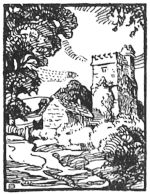
Pengersick Castle.
[Pg 40]
![[An illustration showing a man with halo flying away with two angels on a chariot drawn by two spirit horses (with wings).]](https://www.gutenberg.org/cache/epub/67175/images/i40.jpg)
HOW ST. GERMAN LEFT CORNWALL.

ome fifteen hundred years ago the Church in Cornwall had fallen into grievous heresies, and the Roman Emperor Valentinian decided that a stern, strong man was needed to pull these erring people back into the right way. So he instructed St. Germanus of Auxere to go to barbarous Britain and tell the Cornish all about it. And accordingly St. Germanus, or St. German, as we call him, came.
But the erring people were not at all pleased[Pg 41] with their visitor. They preferred their own priests and their old teachings, and good St. German had a very hard time of it. But he stuck to his task, preached the true faith, performed remarkable miracles and erected a beautiful church. Yet the stubborn Cornish would not make friends with him. On the contrary they persecuted him in many ways, doing their utmost to drive him away, so that they might be left in peace with their old-fashioned doctrines, which they much preferred to the right and proper teachings of this foreigner.
And at last the patience of the saint gave out. The unruly people started a brawl in church during a Sunday morning service. St. German tried to reason with them, but they would not hear him. He prayed for them but they jeered at him, and their conduct became so threatening that the good saint’s companions, fearing for his life, persuaded him to escape from the church.
Poor St. German was heartbroken. He felt that his mission had failed utterly. And in the depths of despair he wandered away out to lonely Rame Head, where he sat by the cliffs’ edge and lamented his lack of success. Here he was compelled to hide from his persecutors for some days, and they say that the very rocks wept with him in his grief, and still weep at St. German’s well.
But at last the furious mob discovered the saint’s hiding place, and a vast crowd, led by the local priests, came swarming up the hill side of Rame determined to destroy the holy man.
[Pg 42]
St. German faced the maddened rabble fearlessly, praying only for deliverance from their anger. Then, as the first stone was thrown, there came a crash of thunder, and in a blaze of light a fiery chariot was seen descending the hill.
The mob started back in terror, but the chariot rolled on to where the saint stood. Two glittering angels were in the chariot. They tenderly lifted St. German from the ground and placed him between them. There followed a great rushing wind, and the amazed and terrified crowd looked upward to see the fiery chariot ascending into the heavens. Then, in mighty dread at the result of their wickedness, the people scattered and fled.
St. German was carried safely overseas, where he lived for many years to continue his pious works. It is even said that after a time he returned to Cornwall again and completed his appointed task. At any rate St. German’s Well still flows, and for many centuries—perhaps if you looked hard you could find them still—the marks of the chariot wheels were to be seen burnt into the rock of Rame Head.
Rame is a magnificent headland, the easternmost of Cornwall, surmounted by an ancient ruined chapel dedicated to St. Michael. It is the nearest point of land to the Eddystone, and from it on a clear day you can see to the Lizard—the whole length of the county.
St. Germans, a quiet little place named after the saint, was the seat of an early bishopric, the splendid[Pg 43] old Norman church marking the site of the ancient cathedral. Both St. Germans and Rame Head are easily reached from Plymouth, St. Germans being under ten miles by rail from that place, and in summer boat excursions may be made to Cawsand, a little over a mile from Rame Head, and up the beautiful Lynher River to St. Germans.
This part of East Cornwall has a distinctive charm of its own. The Tamar, which forms the county boundary, is most attractive to explore. There are many early churches and castles round about, and the variety of river and sea scenery offered here is obtainable nowhere else in the Duchy. That great arm of the sea, that runs up from Plymouth Sound and comprises the Lynher, the Tamar, and the Tavy estuaries, will in itself provide interest for many excursions, while the barren heights of both the Bodmin Moors and Dartmoor are more easily accessible from Plymouth than from any other centre.

Rame Head.
[Pg 44]
![[An illustration showing a man in dark cloak traveling at night, accosted by a specter of an old man.]](https://www.gutenberg.org/cache/epub/67175/images/i44.jpg)
THE SPECTRE OF ROSEWARNE.

ear Camborne, in the mining district of South Cornwall, is Rosewarne, where was once one of the great houses of the county. Two hundred years or so ago an avaricious attorney named Ezekiel Grosse obtained possession of the place by shady means, and this is the fate that befell him.
One night, after he had taken possession of the place, Ezekiel, engaged in studying some deeds,[Pg 45] looked up to find standing before him a queer wizened little man of ghostly appearance, motioning him to follow. The crafty lawyer, afraid only of losing money, told the apparition to go away. But the little man remained, still making his strange signs.
At length Ezekiel asked what he wanted, and the ghost replied: “To show thee where much gold lies buried.”
Gold was a bait the lawyer could never resist, but there was something so grim about the manner of his strange visitor that an unfamiliar feeling of dread came upon him, and he was unable at first to rise.
“Come,” commanded the ghost. “Gold, Ezekiel, gold.”
Ezekiel at last staggered to his feet, now quaking with fear.
“Follow me,” said the spectre in a hollow voice, and the lawyer, torn between emotions of fear and greed, obeyed.
The spectre led the shivering lawyer out into the grounds of Rosewarne and, after a long walk, they arrived at a little dell surrounded by high banks and trees, in the centre of which was a small carn of granite boulders. In the darkness Ezekiel noticed that his guide seemed to emit a weird phosphorescent light, and he was yet more terrified.
Then the spectre turned upon him and said: “Thou longest for gold, Ezekiel, even as I did. Yet I could never enjoy it; see if thou canst. Dig there. Beneath those stones is gold aplenty. Win it and enjoy it, and when thou art happiest I will come to visit thee again.” With this the strange figure gave a wild mocking laugh and disappeared in a blaze of white light.
[Pg 46]
Ezekiel Grosse recovered his nerve and ran back to the house for tools. All night he dug, and uncovered a huge pot filled with ancient gold pieces. It took him seven nights to remove them all, and when he had completed his task he found himself one of the wealthiest men in all the countryside. His ghostly visitor never returned, and after a few years Ezekiel almost ceased to remember him.
Time passed by and the world forgot the past reputation of Ezekiel Grosse. Because of his great wealth, honours and position were showered upon him. Then came a night when he was entertaining a magnificent party in his great Hall. Laughter and the sound of music and dancing made the old rafters ring until, of a sudden, the gaiety ceased as if by magic. In the midst of the Hall appeared the aged spectre.
Ezekiel did his best to turn the matter into a joke, but his guests could not be roused from their inexplicable gloomy emotions. One by one they made excuses and departed and at last the lawyer was left alone with his ghostly visitor.
From that time onward whenever Ezekiel had a party the wizened figure of the spectre was present. He would sit without speaking at the banqueting table or walk slowly among the dancers until at length, gazing full at the Lord of Rosewarne, he would utter an unearthly laugh of derision and disappear.
Soon Ezekiel Grosse’s friends all deserted him and he was left an old and lonely man, whose sole companion was one, John Call, his clerk.
So Grosse sought to bargain with the spectre, and had at last to consent to give up all his worldly possessions[Pg 47] to John Call. When the deeds were signed the ghost finally disappeared, uttering one last demoniac peal of laughter as he went.
Old Ezekiel only survived for a few weeks. One morning he was found dead, and the country folk tell that at his funeral a crowd of grinning demons appeared, which afterwards flew away over Carn Brea, and that from its midst came the same horrible laughter that the spectre had been heard so often to emit.
Rosewarne, the scene of this story, lies in that barren mining country which every visitor to Cornwall should see. It is intensely interesting, and permission is not difficult to obtain, to visit some of the tin mines where an industry, carried on in Cornwall since the days of the Phoenicians, still survives.
The hills and moorland of this district are scarred with old workings and abandoned mine buildings. Rugged Carn Brea, crowned by prehistoric remains and the ruins of an ancient castle, rises 740 feet high, close by the main line between Redruth and Camborne. Here, they say, was the chief centre of Druid worship in the west. This district is easy of access from St. Ives, Penzance, Falmouth or Truro, and a visit to it will ever be remembered with pleasure, bleak and dreary though the mine riddled land may seem at first sight.
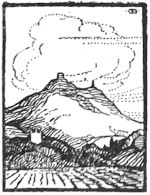
Carn Brea.
[Pg 48]
![[An illustration showing a young woman sitting on rocks with and consoling an elderly person.]](https://www.gutenberg.org/cache/epub/67175/images/i48.jpg)
THE LEGEND OF THE FOUR HALLS.

any an old tale is told of that great waste of sand-hills which fringes the coast of Perran Bay between Newquay and Perranporth. They say that there stood the lost city of Langarrow, once a busy town, that became so wicked that it was swallowed up in a night of fierce storm by the sands, and no trace of it left to offend the earth.
Right on the very edge of these sands, in the parish of Cubert, is the hamlet of Ellenglaze. Hellenclose[Pg 49] was its old name, and that means the “Four Halls.” There is a little known story about this place, or rather about the house that stood there in the very old days, and it explains why the place was so called.
Hellenclose was once much nearer to the sea, but three times the relentless sands overwhelmed it, and each time the Lord of Hellenclose set himself to erect a new dwelling further inland, for they were of a stubborn race in those days, and would not easily submit even to the power of the storms and the winds.
It was a young Lord who built the fourth hall, in defiance of all advice, close by where the present house stands. Wise men warned him that the same fate would befall that as had overtaken the others, but he laughed at them, and his house finished, he rode off to fetch his bride from Meneage by the Lizard.
The night he returned was an ominous one. A great gale was getting up, and the retainers eyed anxiously the restless sand-hills not so far away. But the young Lord was happy and careless and bade his people sleep soundly for no harm would come. But the next morning the invading sands were seen approaching, and panic fell upon the household, who cried out that there was a curse upon the land.
Presently they dragged to the anxious Lord and his new-made wife an old hag whom they had found hiding in a barn. She was a witch they said, and to her was due all their troubles. By this time the cruel sand was already sweeping around the walls of the house, and the young Lord in his trouble gave orders[Pg 50] for the hag to be hanged forthwith, saying that she should not live to cackle over the result of her evil designs. But his beautiful young bride intervened.
Casting herself weeping at her bridegroom’s feet she begged him to spare the old woman’s life. “I believe she is no witch, but one in misfortune as we are,” she cried, and so eloquent were the pleadings of this beautiful girl that all who heard her were moved to tears—all, that is, save the old woman who remained dry-eyed throughout the whole scene. At last the husband relented so far as to promise that the supposed witch should be spared until nightfall. If by then the house remained safe the old woman should go free; if not: “By St. Pirran, she shall hang,” he vowed.
The young bride agreed to this compromise and herself undertook to be responsible for the old woman’s safe keeping. She led her outside the hall, where the sand was now driving in low clouds over her lord’s land, and besought the old dame, if she had any power to do so, to avert the almost inevitable tragedy.
The hag avowed her innocence. “Then the Saints aid us all,” replied the girl, and with that she planted a kiss upon the old woman’s shrivelled cheek.
Now a witch cannot shed tears—that is one of the ways you may always tell one—but a kiss given freely and with good will, can break the bonds of magic that bind a witch; and no sooner had the young bride of Hellenclose kissed the aged woman than tears began to well from her eyes. These fell to the[Pg 51] ground and caused first a tiny trickle then a regular stream which flowed on through the sand towards the sea at Holywell Bay.
And as the stream grew in size, so the invasion of the sands ceased for sand cannot cross running water, and the Fourth Hall was saved.
To-day you will find Ellenglaze separated from the barren sands about a hundred yards away, by a little brook. So long as that flows, the hamlet is safe, but should it ever dry up, they say there would have to be a fifth hall, and the waste would sweep on until perhaps it reached St. Cubert’s Church on the hill inland.
The lonely and fascinating Perran Sands are easily reached from either Newquay or Perranporth. The coast on the Newquay side is particularly fine, for a succession of steep rocky headlands here thrust themselves into the Atlantic rollers, and between them are quiet little sand-fringed bays where one may idle away a summer afternoon with only the sea birds for company.
Newquay itself, with its many fine hotels and its bathing beaches, is one of the most attractive of all the north Cornish coast towns, from which the most impressive of that coast scenery may easily be visited.
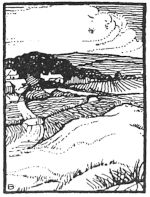
Ellenglaze.
[Pg 52]
![[An illustration showing galleys at sea fitted for war with painted sails, banners flying, archers and spearmen in the crows nest and railings, and oars plying the sea.]](https://www.gutenberg.org/cache/epub/67175/images/i52.jpg)
[Pg 53]
THE STORY OF “JOHN DORY.”

his very old song commemorates the brave doings of the “Fowey Gallants,” as the mariners of that wonderful old-world Cornish seaport were called. They were men, famous throughout the middle ages, as the boldest and most daring of sea fighters.
It possibly has reference to some heroic action fought in Edward III’s reign, when Fowey’s contribution to the King’s fleet is said to have been 47 ships and 770 men.
The song itself was perhaps written a hundred years later than this, but it is certain that in Tudor times it was one of the most popular songs in the land, so well known in the West that Richard Carew in his “Survey of Cornwall,” published in 1602, refers to it in his account of Fowey, and calls it old then.
He says: “Moreover the prowess of one Nicholas, son of a widow, near Foy, is descanted upon in an old three man’s song, namely, how he fought bravely at sea, with John Dory (a Genowey, as I conjecture), set forth by John the French King, and (after much bloodshed on both sides) took and slew him, in revenge of the great ravine and cruelty which he had forecommitted upon the Englishmen’s goods and bodies.”
Carew’s assumption is that John Dory was a Genoese employed by the French King.
Many writers of the 16th and 17th centuries spoke of the song; Dryden described it as one of the most popular in his time. But gradually it came to be forgotten as songs in praise of newer heroes arose.
But at any rate we can take it that “Nicholl’s” feat was no ordinary one, for he came of a race that loved fighting. The Fowey mariners were always ready for a sea fight, engaging in a little private piracy when legitimate warfare was not available. And they took their full share in the struggles against the Armada, and late against the Dutch admiral De Ruyter.
Fowey—Q’s “Troy Town”—has seen as stirring a life as any of our seaport towns. It is still a busy, picturesque little place, straggling along the edge of its beautiful sheltered harbour, at the mouth of which remains of its ancient castle-fort still stand.
It is a fascinating place in which to spend a holiday, warm and sheltered, with excellent opportunities for sailing or sea or river fishing; and its neighbourhood abounds in pleasant walks[Pg 54] and places of interest.
“JOHN DORY”
Verse 1.
[Pg 55]
NOTE.—The “1st Man” should be he of the loudest voice of the three; the others should so restrain themselves that the words of each verse may be clearly heard.
HOW TO SING A “THREE MAN’S SONG.”
The “Three Man’s Song” was the precursor of the more familiar “Round.” It should be sung in this manner: The first man sings, alone, the opening line of each verse and as he proceeds with the second, the second man starts to sing the first. In like manner the third man joins in the harmony with the first line when the first man has reached the third and the second man the second.
In order that all three singers should complete each verse at the same time, it is necessary for the first man to repeat the first and the second lines, and the second man to repeat the first line.
[Pg 56]
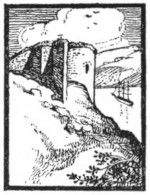
St. Catherine’s Castle, Fowey.
![[An illustration showing Herne the Hunter.]](https://www.gutenberg.org/cache/epub/67175/images/back-cover.jpg)
Miniature of the front cover Illustration of Volume Four
TRANSCRIBER’S NOTE
Obsolete, archaic and unusual spellings have been maintained as in the original book. Obvious typos have been fixed silently.
In the story of John Dory, the phrase “in revenge of the great ravine and cruelty” appears. The word “rapine” comes from French, and a popular form of this word in old French was “ravine”. Consequently I believe that a rendering of this phrase in modern English would be “in revenge of the great rapine and cruelty.”
In the song of “John Dory”, press on the [Listen] button to hear the music. As of this writing, it only works in the html version.
The cover page was produced at Distributed Proofreaders from material found in this book. The cover is hereby placed in the public domain.
The author, “Lyonesse” is a pen-name for George Basil Barham.
LEGEND LAND
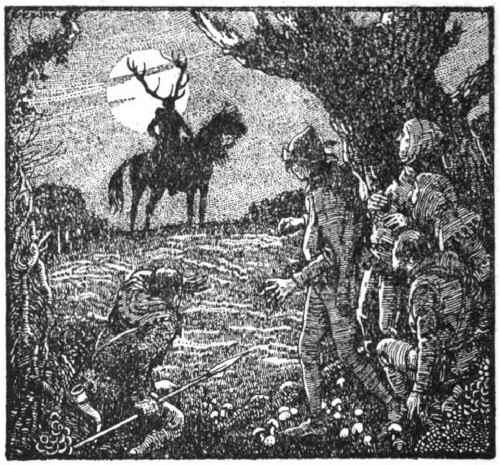
Being a further collection of some of the Old Tales told in those nearer Western Parts of Britain served by the Great Western Railway
Volume Four Price Sixpence
LEGEND LAND
Being a further collection of some of the OLD TALES told in those nearer Western Parts of Britain served by the GREAT WESTERN RAILWAY, now retold by LYONESSE

VOLUME FOUR
Published in 1923 by
THE GREAT WESTERN RAILWAY
[FELIX J. C. POLE, GENERAL MANAGER]
PADDINGTON STATION, LONDON
CONTENTS AND ILLUSTRATIONS

This is a reprint in book form of the fourth series of The Line to Legend Land leaflets, together with a Supplement, “Sumer is icumen in,” the oldest English song.
The Map at the beginning forms a guide to the localities of the first six legends, that at the back to the remainder.

Printed by Kelly & Kelly,
Moor Lane, London, E.C.2
FOREWORD

olume Four brings Legend Land nearer to the great centres of modern life. It comprises some of the old stories told of districts within easy reach of such busy cities as London, Birmingham and Bristol.
In it you will find historic and pre-historic romance mingled. Some of its tales are as old as any in our land, tales born of the very ancient belief that saw in “Druid” stones a human origin. Other stories are romances of much later date, of events almost within the memory of our great-grandparents’ great-grandparents.
Here you will find two legends that come from Shakespeare’s land, legends that must have been well known to that great lover and teller of old tales. And in the legend of Herne the Hunter you will recognise a story which Shakespeare himself told in “The Merry Wives of Windsor.” And it was probably an old tale when he repeated it.
In “King Arthur’s Camelot” you meet with a very old legend of that great hero of British historical romance; and in the story of “Wayland Smith” you get an echo of the lore of the old Pagan gods which invading Anglo-Saxon tribes brought to England soon after the Romans left it.
Manners and customs change; the old creeds die as the new ones arise, yet—and it is very wonderful to realize it—some of the old stories have survived every phase of the passing centuries’ intolerance of the past, and are told to-day in a form not so very different from that in which they were first narrated by our semi-savage ancestors, over their camp fires in the heart of primeval English forests.
But civilization is “improving” away romance very rapidly. And it is worth while to hang on fast to the last remaining shreds of those other days when life, though ruder, had more time for simple dreams of wonderful things.
LYONESSE
[Pg 4]
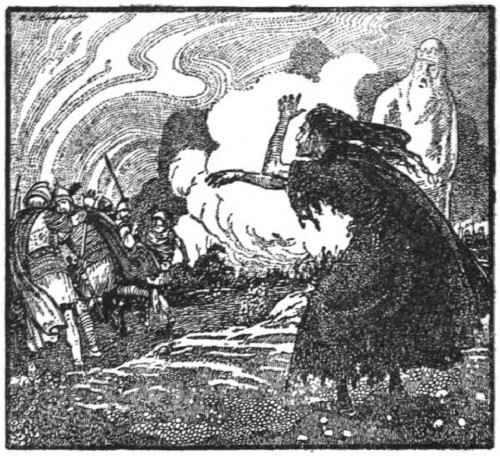
[Pg 5]
THE WHISPERING KNIGHTS.

igh up on an outlying spur of the Cotswold hills, where Warwickshire and Oxfordshire meet, there is a sort of miniature Stonehenge, known as the Rollright Stones; and the Story they tell about them is that they were once a king and his courtiers who, by evil spells, were changed suddenly into Stone.
The Rollrights are scattered about the hill top, seven hundred feet above sea-level, a mile or so from the quiet village of Little Compton. And this is the old Story of how they came there.
Ever so long ago there came marching over the hills a king and his army bent upon the conquest of England. As they neared the summit of the hill the king was met by a witch who told him that he had nearly achieved his desire. She spoke in rhyme, and her words are remembered in the neighbourhood even now.
she said. The king rushed forward, but, owing to treachery on the part of some of his men, his view of Long Compton, which lies in the valley below, was impeded.
Then the witch turned to him with a croaking laugh, and muttered:
[Pg 6]
The unfortunate king, although within a few paces of a spot from which he might have viewed Long Compton and so become ruler of this realm, was unable to move a step further. His joints became stiff, his energy left him, and in a few minutes he had turned into stone. And there you may see him to-day as “the King Stone,” a grey weathered monolith standing stark in a field, but in a place from which Long Compton is invisible.
But his treacherous supporters who had hindered him from success did not escape. The old story tells that there were five knights who led the company. Seeing their leader’s strange fate, they tried to escape. But the same doom overtook them. A few hundred yards from the “King Stone” is a group of five large upright slabs. These are the “Whispering Knights,” turned to stone in the very act of conspiring against their king.
Nearer to the silent king is a circle of stones, once his faithless soldiers, and all about grow elder trees, said to be descendants of that witch who was herself transformed into an elder after her magic spell had worked upon the king and his men. They tell you that if you stick a knife into these elders you will sometimes draw blood.
The Rollright Stones form a weird relic of some long forgotten time. Men have written of their strange appearance throughout many centuries. Bede called them the second wonder of the kingdom. Whether the legend of their formation be true or not, it must have been some very important event that caused them to be erected.
[Pg 7]
You may best reach them from Rollright station on the line between Banbury and Chipping Norton, and if you dare venture up to visit them on a moonlight night, they say you may find the fairies at their revels, dancing all about.
This is a peaceful English country of hill and vale, fine country estates—Compton Winyates with its matchless Tudor mansion is near at hand—and little churches, rich in architecture, that will repay a visit. Here you are on the outskirts of Shakespeare’s land, real generous England, full of history, that has not changed so very much since the spacious days of Elizabeth—the England that the English tourist all too seldom sees.
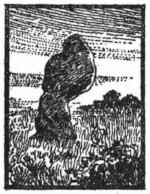
The King Stone.
[Pg 8]
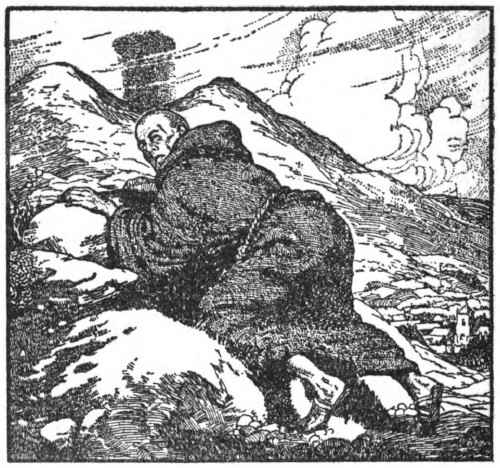
THE SHADOW CURSE OF THE RAGGEDSTONE.

ear the middle of England, where the Malvern Hills rise abruptly to a height of nearly 1,400 feet above the sea, is the double-peaked rugged Raggedstone hill about which several strange old legends centre. A restless spirit is said to haunt the bleaker portions of the summit, but a stranger legend is that of the Shadow Curse, called down upon this hill by a monk of Little Malvern in the olden time.
[Pg 9]
Little Malvern lies in the plain at the foot of these hills, and at the Benedictine monastery there, as the old story tells, there was once a rebellious brother. His offences against the monastic discipline were so serious that the Prior decreed, as his punishment, that he should crawl on hands and knees every day and in all weather, for a certain period, from the monastery to the top of the Raggedstone and back again.
The wretched monk had to obey, and day after day, week after week, he performed his penance. But the pain and degradation of his task embittered him, and they say that before his punishment was completed he died upon the hill of exhaustion and humiliation. Others say that he sold his soul to the devil in order to be free of his hated task, but anyhow before he disappeared from human ken, he put a bitter curse upon the hill that had caused him so much suffering.
He cursed with death or misfortune whomsoever the shadow of the hill should fall upon, having in mind that in those days of sparsely populated land the people who would suffer most would be the Prior and his brethren in the monastery beneath.
Now the shadow of the Raggedstone is very seldom seen. Only at rare times when the sun is shining between the twin peaks does it appear, and those who have seen it describe it as a weird cloud, black and columnar in shape, which rises up between the two summits and moves slowly across the valley.
Many stories were told, in times past, of the misfortunes that happened to those upon whom this uncanny[Pg 10] shadow fell; and it is recorded that Cardinal Wolsey was once caught by this weird cloud, and to that the old folk attributed the misfortune that came to the proud man when at the height of his power.
Wolsey in his early days was a tutor to the Nanfan family whose house was at Birts Morton Court, a couple of miles from the foot of Raggedstone. The young tutor fell asleep in the orchard one day, and awoke suddenly, shivering, to find the strange unearthly shadow moving across the trees.
Much of Little Malvern Priory, the home of that miserable monk of long ago, remains to-day. Its domestic buildings are almost intact, with amazing good fortune having escaped the common fate of such edifices. There are, too, the old monkish fish ponds, now lily spangled in spring time, and an old preaching cross. The parish church is part of the old priory church and contains a finely carved rood screen and some most interesting stained glass.
Great Malvern, some three miles away, clinging as it were to the side of the great Worcestershire Beacon, is a place with world-wide fame. It, too, has its great priory church, and all the attractions and conveniences of a favourite inland resort.
But the chiefest charm of the Malverns—there are seven of them—is their hills. These form a glorious range, of varying barren and wooded mountainous country, flung as it were as a far outpost beyond Severn of the wild Welsh mountains many miles to the westward.
The view from these Malvern Hills is, perhaps,[Pg 11] unequalled. They say nobody knows exactly how much of England and Wales can be seen from them. Fifteen counties are certain, and in that range is included the Wrekin, the Mendips, and the Welsh mountains as far as Plinlimmon.
On the fine upstanding Herefordshire Beacon is, perhaps, the best specimen of an ancient British camp that we have. Tradition says that here Caractacus defended himself from the Romans.
It was “on a May morning on Malverene Hulles” that Piers Plowman had that vision of which Langland wrote five hundred and more years ago.
Few centres in our country offer such varied scope to the holiday-maker as the Malverns, where nature and history vie with one another in the matter of attractions.
The fresh upland air is tonic and health-giving. That weird dark shadow of the Raggedstone can never have fallen here, or, if it have, its mystical power has become impotent by reason of the many beauties of the place.
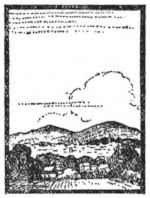
The Malvern Hills.
[Pg 12]
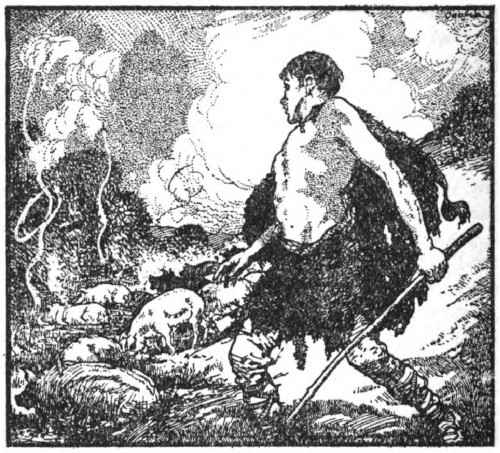
HOW BATH WAS DISCOVERED.

ome people may tell you that the Romans discovered Bath, but the old story gives the honour to a British Prince, Bladud, who is, variously, said to have been the father of King Lear, and the eldest son of King Lud. Like these two illustrious monarchs, Bladud came in time to be king of Britain. But that was after he had passed through a very sad experience.
[Pg 13]
Prince Bladud, as was becoming the eldest son of a king, spent many years in Athens studying the liberal arts and sciences. But, alas! while in Greece he became a leper, and on his return to Britain he had to be shut away from his fellow-men, for fear that he should infect them with the dreaded disease.
The Prince bore his confinement patiently for a time, but at last it became unendurable, and he escaped in disguise, and went out into the world to forget his royal birth and to earn his living as best he could. His wanderings brought him to the hamlet of Swainswick, a few miles from where Bath now stands, and there he found the only occupation given to one afflicted as he was, that of a swineherd.
Here for some time he carried on his lowly duties, content to be a free man, no matter how humble his station in life. And they say that early one winter’s morning when he was out in the neighbouring woods with his pigs, the animals suddenly became restive. Before he could stop them a large part of the herd had taken panic and rushed furiously down a hill-side into a swamp, at the foot where they began to wallow in the mud.
Bladud pursued them, wondering that pigs should seek to roll in cold muddy water on a winter’s day. But when he reached them, he found, to his surprise, that the water and slime in which they rolled was hot, and that steam arose from the marsh. This explained the problem to the Prince, though he marvelled greatly at the existence of such springs.
But there was another surprise in store for him.[Pg 14] He noticed that those pigs that habitually went to the hot swamp were in ill-health and afflicted, somewhat like himself, with skin diseases. After a short time they became fat and well, their coats as clean and glossy as any in the herd.
“If this marvel can come to base animals,” Bladud mused, “why should it not come to me?” So he determined to try the effect of the hot springs upon his own complaint, and after a few weeks’ bathing in them, to his intense joy, he found his leprosy leaving him. By summer he was cured completely of his affliction, and he returned to the king, his father, to announce his good fortune.
King Lud, who had mourned him as dead, was over-joyed to see his eldest son again; more joyful still to find him cured. So Bladud resumed his duties at Court, and in due time, when Lud died, he became King of Britain. Then it was, as a token of gratitude, and that others might benefit from the miraculous waters he had found, that he built a great city on the scene of his cure, and that city we know to-day as Bath.
Of course, when the Romans came, they were delighted to find this wonderful “spa” as we call it. They put up great buildings, and their chief men visited Aquæ Sulis, as they called it, to be cured of gout and rheumatism, and a score of other complaints. And because of the wonderful buildings they left behind them—and many of them remain to this day—people, who do not know the old story, say that they founded the city.
[Pg 15]
But no matter who really did found it, we know that for nearly 2,000 years people have been visiting Bath and finding a cure there which they have sought elsewhere in vain.
Bath is a wonderful city set in glorious surroundings, and you need not be an invalid to enjoy a visit there. With its memories and relics of Beau Nash, and the spacious days of the eighteenth century; its wonderful old Abbey Church, its Roman remains and its sunny sheltered walks, Bath is an amazingly attractive place in which to spend a holiday. The country round about is full of interest, the town possesses every attraction a holiday resort should possess.
Of its waters, let the doctors speak. They will speak of them as enthusiastically as Bladud must have done, and tell you that, in Bath, you may find all the benefits that so many people travel hundreds of miles to Continental spas to seek.
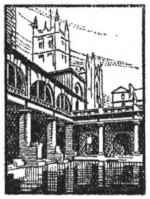
Roman Remains at Bath.
[Pg 16]

KING ARTHUR’S CAMELOT.

his is the story the people of the country-side have been telling from time out of memory. Very learned men have disputed their facts and warred and wrangled over great Arthur’s history, and you must please yourself which side you take, but this is a story of Cadbury Castle, which tradition[Pg 17] holds was King Arthur’s Camelot, where that famous hero:
And it was here, too, that was installed the immortal Round Table, with the chivalrous knights that sat about it.
You will find this Camelot a mile or two from Sparkford station, between Castle Cary and Yeovil, on the main line from Paddington to Weymouth. It is a great rounded hill seared with ancient ramparts and ditches, and crowned by a mound which was King Arthur’s palace.
They will tell you that Cadbury Castle is slowly sinking into the earth; that at one time it was vastly bigger. But they will tell you, too, that King Arthur has not forgotten his old home, and that he and his knights may often be seen galloping round the old fortifications on moonlight nights, mounted on gallant chargers shod with silver shoes.
And should you doubt this, antiquarian records will prove you wrong; for on the hill some years ago, a silver horseshoe was dug up.
From Cadbury a faint path may still be distinguished running towards Glastonbury—you can see Glastonbury Tor from the top of Cadbury Castle—and along this track, if you are lucky, you may sometimes see the great King, a sad expression on his face, his knights with their attendant squires[Pg 18] in his train, riding back to fabled Avalon, which is Glastonbury, and his tomb in the abbey there beside that of Queen Guinevere.
It was from Cadbury, when Camelot’s towers crowned the hill, that the knights set out on their quest of the Holy Grail.
You will not find it hard to believe these old legends, if you sit for awhile in the silence and peace of the great earth bulwarks of Cadbury Castle and look out across the pleasing country beneath you. You can almost hear the faint jingle of harness in the air, and the soft whisperings of dead and gone men and women who had looked upon Arthur himself.
Apart from its legendary interest, Cadbury Castle is one of the most remarkable places in all Somersetshire. Four high earth walls surround the hill, the innermost faced with stone. Within the lowest rampart you will find King Arthur’s well; on the hill side strange terraces that were once, they will tell you, shady gardens where fair ladies walked in the cool of a summer’s evening.
The little stream, the Cam, flows from the foot of the hill, and close at hand are the villages of Queen Camel and West Camel, again suggesting the old name of Cadbury.
But Somersetshire is steeped in Arthurian legendary lore. In the far north of the county near Clevedon another Cadbury disputes with our hill the honour of having borne upon it Camelot. And Glastonbury, almost midway between the two, is the very centre of Arthurian romance.
[Pg 19]
Around the history of the great King has arisen so much controversy that you must read the experts for yourself and make your own choice. And what could provide a more glorious holiday amusement than a quiet journey through this, King Arthur’s own, land on a pilgrimage to the many beautiful places it holds that commemorate in name and tradition the life of the greatest hero of romance in Western literature?
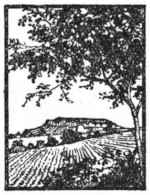
Cadbury Castle.
[Pg 20]

THE WITCH OF WOOKEY.

obody knows how long ago it was when the Witch of Wookey was alive, but she was a terribly hideous person, and she did all sorts of horrible things until a monk of Glastonbury Abbey decided that she had wrought quite enough evil, and determined to rid Somersetshire of her baleful presence.
She lived in a grim cavern a mile or so from that wonderful cathedral city of Wells, and to this day you may visit Wookey Hole, her habitation, and see the[Pg 21] very rightful fate that overcame this wicked woman. As an old poet wrote of her:
They say that in her youth, she was a very beautiful woman, yet no man fell in love with her, and so, becoming embittered, she made a bargain with the powers of evil, so that she might wreak her vengeance upon all mankind for the slight, she held, they had put upon her.
The devil gave her nine imps to assist her in her wicked work, and she, with her loathly helpers, sat in Wookey Hole, plotting misery for all the country-side. She blighted the crops, sent murrain among the flocks and herds, wove spells that created suspicion in happy homes and turned family love into violent hatred. But particularly the witch delighted to cause lovers’ quarrels. It was a happy day in Wookey Hole in those times, when one of the demons had caused a country lass and her swain to quarrel on the eve of their wedding. Then it was that the sounds of demoniac laughter that issued from the cavern were at their loudest.
But all this sorrow that fell upon the people touched the heart of a young monk of Glastonbury. He had been disappointed in love, and had found consolation in the cloister; but he was determined that others’ lives should not be similarly ruined if he could help it. So he went up to Wookey to beard the hag in her den.
[Pg 22]
No other possessed such courage, and the young monk went alone. He approached the place chanting a psalm, then, with holy water, he sprinkled the outside of the cavern and began the old service of exorcism. There was tremendous confusion within the cave at this unexpected intrusion. The witch rallied her servants around her and started out to do great violence to this reckless priest; but before she emerged, the monk, singing a “Paternoster,” fearlessly entered the “Hole.”
He sprinkled with holy water all that he encountered—and all that the miraculous liquid touched turned to stone. Never from that moment did any further evil issue from the cave at Wookey.
And, to-day, if you go there, you may see, as they have been these many centuries past, the petrified witch in her kitchen, cut off suddenly by this good brother of Glastonbury in the very midst of her wickedness, with her various household utensils, also turned into stone, all about her. Anyone may enter Wookey Hole now, and emerge unharmed.
Wells is your best centre for visiting Wookey. The city itself with its splendid cathedral, its ancient houses and its moated Episcopal Palace, is one of the most interesting in all England.
Glastonbury is near at hand, with the remains of its great abbey from which the good monk came, and its marvellous thorn tree, as legend has it, sprung from the staff of Joseph of Arimathea, who, having wandered from the Holy Land, decided to end his days in this pleasant place.
[Pg 23]
This is traditional Avalon, a town, perhaps, richer in history and romance than any other in our land. King Arthur and Guinevere his queen, they say, were buried within the walls of the ancient abbey over which, as the old tale tells, St. Patrick and St. Benedict once presided as Abbots.
And, should you weary of history, there are all the natural beauties of the Mendip hills for you to explore; for both Wells and Glastonbury lie on the slopes of this beautiful range.
Few places in Europe have so much of interest to offer the visitor as Wells and Glastonbury and that pleasing country all around, over which, in the dark ages, the Witch of Wookey wielded her gruesome sway.
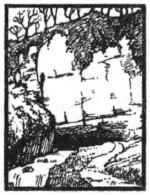
Wookey Hole.
[Pg 24]
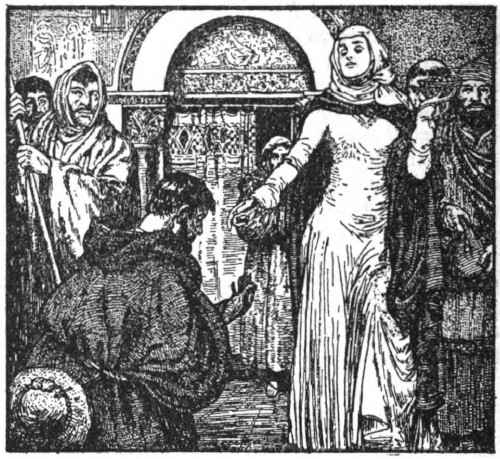
GUY, OF GUY’S CLIFF.

ome people may tell you that there never was such a person as the valiant Guy, Earl of Warwick, who slew the terrible Dun Cow that terrorized middle England in the old days, and, single handed, defeated the giant Colbrond, and cut off his head. But if you go to Warwick’s beautiful castle you may see, to-day, the brave Guy’s armour, and[Pg 25] some bones of the ferocious cow. And there is the old tale of Guy, handed down for centuries, to prove that this mighty warrior really did live.
This is the old tale. After Guy had slain the Dun Cow, and had been to the Holy Land on a pilgrimage, he returned in disguise, and unrecognised, feeling that he wished to withdraw from the world and live a secluded life as a hermit. But before he did so he undertook the slaying of the giant Colbrond. Having killed this monster and cut off his head, he slipped away quietly and wandered slowly to his home at Warwick.
There his wife, the good Lady Phyllis, awaited his return from Palestine. She had no idea that he was home again, nor did she recognise him in his rough pilgrim’s dress when he, together with other wayfarers, presented himself in the Great Hall and received from her own hands the alms that she gave daily to the poor.
And Guy did not announce his identity. Instead, he passed on and sought out a hermit who lived in a cave near by, seeking spiritual comfort from the holy man.
After Guy had been with the hermit a very short time, that pious man died; and Guy decided to take his place. And so, for two years, this once mighty warrior lived the hard, austere life of a recluse in a bare cell, only a mile or two from his own proud castle.
But death was creeping upon him. And, when he realized that he had but a few hours more to live, he[Pg 26] sent, by a trusty messenger, his wedding ring to the Lady Phyllis, begging her to come and take charge of his burial. She came at once, all filled with fear and distress, bringing with her the bishop and high clergy of the diocese. But there they found the great Guy, dead, on the steps of the altar of his little chapel. And there they buried him, and, only a few weeks later, the Lady Phyllis by his side, for she too died swiftly, of a broken heart.
And the old story is still told about the country-side to show how one who had fame, great wealth, high position, and love, sacrificed it all for the lowly yet holy calling of a simple heremite.
All this happened so long ago that nobody knows exactly when it was, but you may still see at Guy’s Cliff, that beautiful old place a short walk from Warwick, the cave in the rock where the hermit and Guy lived. And in the little chapel of St. Mary Magdalene there, you will see carved in the living rock a mighty figure, eight feet high, of the fearless Guy; though time has wrought much damage to this strange effigy.
Warwick and Leamington are both close at hand; Warwick, one of the most picturesque towns in the whole country with Shakespeare’s Avon flowing gently by it, and the grim and wonderful Warwick Castle with its grounds stretching to the river’s edge. And Leamington, that bright clean-streeted spa, with its healing waters, and its quiet atmosphere of other days, when our great-grandfathers posted to it from all parts of the country to drink the[Pg 27] waters and to indulge in the gaiety of the latest and most fashionable of inland watering-places.
All round about is the rich leafy England that Shakespeare knew so well. Stratford-on-Avon is but eight miles away. Shottery—the village of Shakespeare’s wife, where Anne Hathaway’s charming little cottage still stands—Henley-in-Arden, Charlecote, and Hampton Lucy; pretty historic names we know so well, are all in the neighbourhood.
This country has a sixteenth century atmosphere even now. It is one that the foreign visitor seldom misses; yet the British tourist knows all too little of it and its peculiar rural beauty and charm.
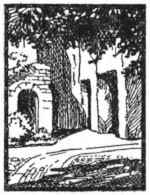
Guy’s Cliff Caves.
[Pg 28]
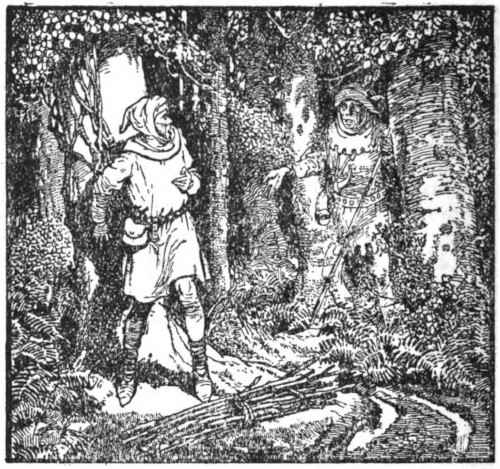
THE GHOSTLY BISHOP OF FINGEST.

estling under the Chiltern Hills, at the head of the quiet Hambleden valley, through which a tiny stream runs to join the Thames a couple of miles or so below Henley, is the sleepy little village of Fingest, where, in days gone by, the Bishops of Lincoln had a palace.
One of these prelates, Bishop Burghersh, lies buried here, but they say that he does not rest quietly in the[Pg 29] tomb in which they laid him, with pomp and ceremony, these five hundred years and more since. For Burghersh in life was not all that a bishop should be.
Burghersh was more a prince of the Church than a humble shepherd of souls, and his worldly ambition led him to adopt the most unworthy means in order to aggrandize his estate. He played the haughty tyrant over the simple timid villagers, and shamelessly grabbed here a piece and there a piece of the common land to add to his own park, and to provide him with the hunting that he loved more than the services of the Church.
And very stern was Burghersh, too, in upholding the game laws. The wretched peasant caught poaching on land which was justly his was given little mercy. The bishop’s foresters had the strictest orders to keep the villagers in their place—which was the other side of the Episcopal fence.
But at length Burghersh died, and they buried him with all the elaborate ritual of those far away days; and the village folk were not, perhaps, so sorry as they pretended to be, for at last, they thought, they were rid of their tyrant neighbour and looked for better times under his successor. But they were wrong.
Bishop Burghersh, in death, so the story goes, developed the conscience he had never known in life. He could not rest in peace.
Soon the rumour began to spread about the lonely country-side of a ghostly wanderer with the dead bishop’s face and voice, but clad as a keeper or forester, who glided among the trees of the Episcopal[Pg 30] park, and put himself in the way of passers by begging them to help him find repose.
Not until all the land that he had stolen from the people, to enlarge his park, was returned to the rightful owners could he cease his nightly wanderings, he said. He appeared to his successors, beseeching them, for his soul’s sake, to dispark the ill-gotten land, but they would not listen to him. Instead they tried to put him to rest with chaunt and prayer; but this was unavailing.
Time went by, and others held the bishop’s land, and held fast to it, despite the ceaseless pleadings of the unhappy wraith, and even to this day they will tell you, sometimes floating along by the hedge of some quiet meadow, or flitting between the trees in a lonely copse, you may see a pale, sad-faced form in Lincoln green, seeking someone who will listen to his weary appeal, and return to the people the common land which he enclosed in the days when Edward III. was King of England.
Fingest to-day, you will find, a very charming little place amid woods and hills. Its fine old church has not changed much since Bishop Burghersh lived his selfish life in this quiet vale. There are traces of Saxon work in the Church, masonry that was three or four hundred years old in the bishop’s time, and an unusual tower of great age and height, ending in twin red gables, rises high above the little church.
Down the valley you come, in a few miles, to Hambleden, with its picturesque old manor house, and a little further on to a beautiful reach of the Thames,[Pg 31] midway between Henley and Medmenham, with its old abbey and its memories of the eighteenth century “Hell Fire Club,” and the grim stories told of the wild and extravagant doings of its dissolute members.
Or go north from Fingest up through the beech woods and leafy lanes of the Chilterns, or west, till you rise, in a few miles, to six or seven hundred feet above sea level in a country that is as remote and unspoilt as you can wish.
All this you may reach from London in a summer day’s trip. Strike north from Henley or west from High Wycombe, or West Wycombe, and you will soon find yourself among little forgotten villages set among the woods where the Chilterns slope down to the Thames, amid scenery that is as charming as any England can show.
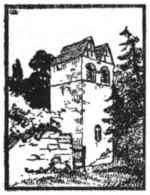
Ruins of Fingest Palace, and Fingest Church.
[Pg 32]
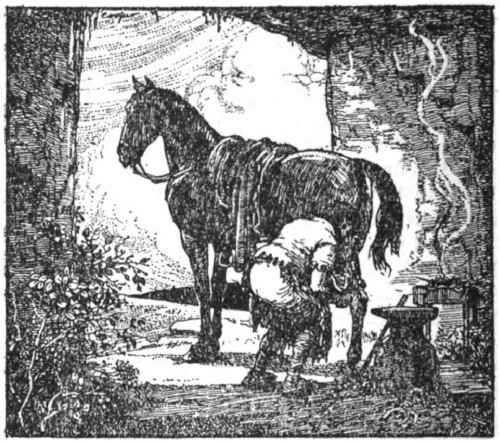
WAYLAND SMITH AND HIS CAVE.

t was such a long time ago since Wayland Smith came into this country that even the most learned men are uncertain as to his origin. He came, they think, as Weland, a heathen god, kinsman of Thor, the Scandinavian God of Thunder; and for many years he was a being of great importance in Pagan England. But he fell upon bad times.
Weland seems to have been a hard-working and humble deity, and when men would no longer work[Pg 33] for him, he had to work for them. And very good work he did, too, it seems. Perhaps, in his better days, he made Thor’s hammers for him; anyhow, when he came down in the world, he took to the blacksmith’s trade.
You will come across traces of poor Weland in many parts of the country, but nowhere will you find a stranger relic of his working days than in his smithy—Wayland Smith’s cave they call it now—quite close to the side of that ancient track-way that skirts the summit of the Berkshire Downs above the White Horse Vale.
The road, the Ridgeway, was old when the Romans came. And perhaps it was because of its popularity that Wayland Smith started his business near at hand. Anyhow there is his cave to this day, a strange erection of two great upright stones surmounted by a third, and there, the old story tells, he shod the horses of any who would employ him, at less than market rate, so long as they carried out a perfectly simple arrangement.
Naturally enough, since once he had been a god and had had men and horses sacrificed to him, Weland’s pride would not permit him to come out and tout for trade; so it was well understood that should you wish his services you placed a silver penny upon a flat stone near the cave, left your horse by it, then went away and sat down out of sight for ten minutes.
Soon you would hear the sound of hammer and anvil, and presently, when you returned, you would find your horse well shod—and your penny gone.[Pg 34] Weland was very particular about that penny; he would take neither more nor less for his work, and unless that actual sum was placed upon the stone you might wait in vain. He would have no dealings with you.
Nowadays silver pennies are out of fashion and a sixpenny piece is the proper fee. And, though few travellers use the old Ridgeway in these times, there are some who believe that, if you have faith, you may still have your horse shod for sixpence, high up there on the lonely downs, if you carry out the proper procedure.
You come to the cave from Shrivenham station, a few miles east of Swindon; thence the Lambourn road will lead you straight up on to the downs. On the summit you will find the soft-turfed Ridgeway, which you must follow to the left and you will come in a short time to Wayland Smith’s lonely abode.
If you continue still further along the old way, you find yourself at mysterious Uffington Castle, the gaunt earthwork from which Alfred the Great routed the Danish invaders over a thousand years ago. Here you are eight hundred odd feet above the sea, and on camp-crowned Whitehorse Hill, on the side of which is the famous White Horse that names both the hill and the vale beneath. Alfred caused this horse to be cut in the close turf, they say, to commemorate his great victory over the invading Danes; for this, historians will tell you, is Aeschendune, the scene of Alfred’s mighty and triumphant battle.
[Pg 35]
East, south and west, the bare downs stretch, away from you for miles, hiding in their folds little lonely villages, fertile and sheltered, and bearing on their summits a thousand memorials of the early peoples that went to make up our English race.
Here is a holiday country of which few tourists know; a wide open upland district of keen fresh winds, and sweet soft turf, where you may wander for hours with nothing but the grazing sheep, or perhaps a gipsy encampment, to remind you of civilization.
There is a charm about this solitude that makes it easy to realize why poor dethroned Weland chose this land in which to hide his wounded pride.
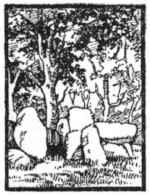
Wayland Smith’s Cave.
[Pg 36]

HERNE THE HUNTER.

he story of Herne the Hunter was familiar in Shakespeare’s days, as those who have read “The Merry Wives of Windsor” know; but like all old stories it has many versions, and some say that Herne lived in Plantagenet times, others as recently as Good Queen Bess’ reign; some, that he was a poacher, others, a keeper. But all agree that he haunted Windsor Forest, and some say that he does so to this day.
[Pg 37]
As the legend is generally told Herne was a royal keeper whose unusual skill at the chase caused him to become a great favourite of his royal master, and at the same time made his fellow foresters mighty jealous of him. So they combined together to try to plot his undoing.
To one of their secret councils, held beneath great oaks in the heart of the forest, there came one day a mysterious dark man of unusual stature and strength, whose face seemed familiar yet whom none could place. To their enquiries he answered gruffly that he lived on the outskirts of the forest, and that he knew their designs and could help them, if they wished it.
The jealous keepers at once accepted his offer. But he bargained with them, asking as the price of his aid that they should each grant one request whenever it was made. This was agreed, and the stranger disappeared, telling the now rather alarmed foresters that they should soon have proof of his powers.
Within a few days it was noticed that Herne’s skill began to fail him. He could no longer shoot straight, nor ride fast; and very swiftly he fell into disfavour. His rivals were delighted, particularly when the day came that he was dismissed from the Royal service.
That same night there was a terrible thunderstorm, and in the morning the body of Herne was found hanging from a lightning-stricken tree in the Little Park. He had killed himself.
For a time nothing unusual happened; then[Pg 38] strange stories began to get about of a ghostly huntsman, in figure like the dead Herne, with stag’s horns growing from his head, who rode through the forest at night on a fierce black charger, harrying the King’s deer. This proved to be only too true as the depleted herds of deer soon proved, and the keepers were threatened with dire punishment if the depredations were not stopped.
The keepers, greatly alarmed, went the next night to Herne’s oak to see if the story were true; and there they were met by the dark stranger. But now there was no doubt as to his identity. He appeared in a flash of sulphurous flame, and they knew him to be the Evil One. He told the terrified men that Herne would appear to them soon, and that they must do exactly what he bade them do, otherwise he would seize their souls.
Soon Herne appeared, a ghostly figure with huge antlers, and commanded his fellow-keepers to assemble at the oak the next midnight with horses and hounds equipped for the chase. They had to obey, and night after night, led by the ghostly huntsman, the party swept through the forest.
Their wild doings naturally quickly reached the ears of the King, and he summoned the keepers, demanding an explanation. In terror they confessed how they had plotted Herne’s ruin, and the King, furious at their impious action, caused all of them to be hanged upon Herne’s oak.
But the ghostly chase still went on, they say, and even to this day in the dark midnight hours some[Pg 39] people believe you may hear, far away in the Great Park, the distant sound of a huntsman’s horn, and see flashing through the trees the ghostly chase led by an antlered man on a huge black horse.
Herne’s oak has gone now. It stood in the Home Park, a grim withered riven stump near the footpath to Datchet, until some fifty or sixty years ago; and few cared to pass it at midnight.
But Windsor Park in daytime has nothing eerie about it. It, and the wide bracken-covered, sandy forest country that surrounds it, is delightful in Spring, or on a hot summer’s day. Or in autumn, when the leaves and bracken are turning, one must go far to find a more beautiful district. The whole country is steeped in history and romance.
From Windsor, with its magnificent castle—and just across the river, historic Eton—the forest district stretches away south and west for miles. Here, although so close to London, one may find the solitude and rest that many travel far afield to seek—and fail to find.
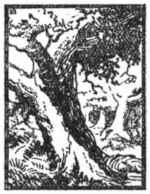
Windsor Forest.
[Pg 40]
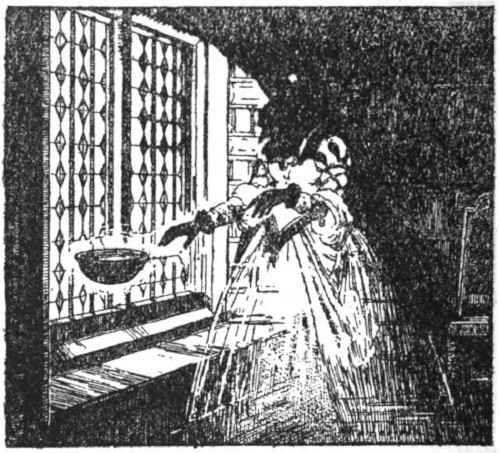
THE GHOST OF BISHAM ABBEY.

his legend begins with the story of a rather dull little boy who found his lessons very trying—and, perhaps, the glistening Thames, which he could see from his schoolroom window, very attractive—in the days when Tudor sovereigns reigned in England. His name was Hobby, and his home was Bisham Abbey, which still stands by the riverside just opposite Great Marlow. And because the child could not write in his copy-book[Pg 41] without making blots, he was whipped so severely that, as the old tale goes, he died. But that is only the beginning of the story.
It was his mother, Lady Hobby, who chastised the child. When you see her portrait, as you still may at Bisham, you cannot believe she meant to be so cruel. She must have been sorry for her harshness; at any rate she has been punished for it, for she can find no rest in death. Though over three hundred years have passed since they placed her in her grave, her ghost still floats through the panelled chambers of Bisham, so they say.
It is a queer apparition this. It is that of a stately woman dressed in coif, weeds and wimple, with grave face and long thin hands, in front of which a basin, suspended by no visible means, always appears. The lady is forever trying to wash her hands in the basin, but it always moves from her before she can achieve her desire. Not until she can cleanse those delicate hands, can she find repose, they will tell you.
And a curious thing about the ghost is that it appears as a “negative,” to use a photographer’s term. What in life was white is in the spirit black; and what was black, now white. The wraith is seen with black face and hands, black coif and wimple; the basin is black. But the sable gown is white, the shoes white. White eyes look mournfully from the dark face.
You may not credit this strange story, for few people living have seen the wandering lady. Yet undeniable records will tell you that eighty odd years since, when[Pg 42] they were doing some repairs to the old building, a window shutter was removed in the room in which tradition asserted the unhappy boy was taught. Pushed in between shutter and wall, were a number of children’s copy-books of the Elizabethan time. One of them, yellow and soiled with age, corresponded exactly with the copy-book of the story. There was not a single line which was not blotted.
Bisham Abbey is a wonderful old place; its history starts with the Knights Templars in the reign of King Stephen of turbulent memory. Later it became an Augustine priory, and later still, when it had passed from the monks, poor harassed Princess Elizabeth was there, a prisoner in charge of Sir Thomas Hobby, in those times when no one could guess that she was to become the great and glorious Queen Elizabeth.
The old building has seen the Thames flow by to the sea for eight centuries and more, and still it remains, one of the most attractive of all the famous houses that have arisen upon the banks of the great river. It is a short mile across the bridge from Great Marlow, that restful riverside town on one of the most pleasing reaches of the Thames. Here the river is at its best, bordered by peaceful shady lawns, where you may idle away a hot summer afternoon amid refreshing scenery that only England can show.
Down stream, seven miles past Cookham, you come to busy Maidenhead. Upstream eight miles and you are at Henley Bridge. Cookham lock they call the[Pg 43] most beautifully situated of all on the river. Wild flowers grow in profusion on the banks of the tow-path side, and the famous woods of Cliveden look down upon the gently flowing river.
Yet, if you be wise, sometimes you will leave the fascination of the river and wander a mile or two inland and see the queer, quiet little villages that stand away from the river bank; or adventure, perhaps, from Bourne End up the Wye valley towards High Wycombe and find picturesque Penn—not the home of the family of the founder of Pennsylvania, but of one with which it was connected—and see in the church the memorials to some of the grandchildren of the famous William Penn.
To find Penn’s grave you must go a little further afield, through Beaconsfield to Jordans, where in the little Quaker burial ground that one of the greatest of the founders of the United States lies buried in a simple grave.
In all this fascinating country you are seldom more than thirty miles from London, and always within touch of a station from which you can reach Paddington in about an hour’s journey.
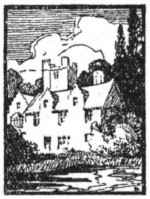
Bisham Abbey.
[Pg 44]
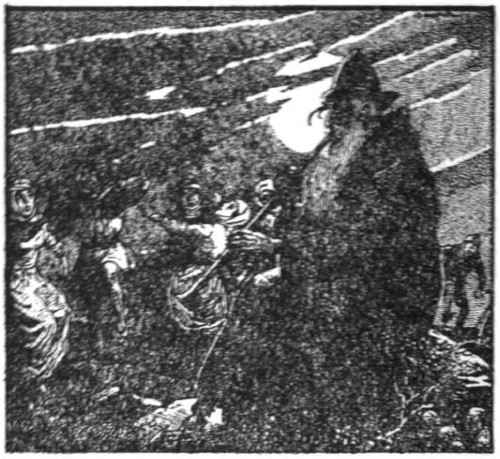
THE EVIL WEDDING OF STANTON DREW.

nder the southern slopes of bold Dundry Hill in North Somersetshire you will find the queerly named little river Chew, on the banks of which is the village of Stanton Drew. Nowadays it is an out-of-the-way little spot, but far back in history it must have been a place of considerable importance, for close to its church are the remains of what was once a gigantic building—some call it a Druid temple—of a very early race of men.
[Pg 45]
There are the relics of at least three stone circles, and about the smallest of these a strange story is told. It is the story of the Evil Wedding, and it explains why the stones came there.
Long, long ago, as the tale goes, there had been a marriage at Stanton Drew, and the wedding party met on the place where now the stone circle stands to indulge in feasting and dancing. It was on a Saturday, and the festivities were at their height when midnight struck. Then the harpist, a pious old man, who was playing for the dancing merry-makers, refused to continue any longer, saying that he would not profane the Sabbath.
Each member of the party tried to persuade the aged musician to continue, and chief among the suppliants was the bride, who grew very angry at the harpist’s continual refusals. She would go on with the dance for all his obstinate ways, she said, and she would find another musician even if she had to go to the nether world in search of him.
At that moment a venerable old man with a long grey beard wandered out of the night and asked what all the altercations was about.
When they told him, he gave a merry laugh and said that he would play for them; so the pious old harpist departed, and the dance began again.
The new musician, playing on a pipe, started off with rather a doleful air, but he soon livened up, and very quickly the dancers were whirling round and round in the maddest abandon. But to their consternation as they grew tired, and wished to stop,[Pg 46] they found they were unable to do so. The more weary they became, the harder the piper played, and when they begged him to cease he merely laughed at them and changed his tune to one yet more lively.
At last dawn began to show in the sky, and the now frenzied and terrified dancers saw their musician remove the pipe from his mouth. But they saw, too, when he got up, that he had a club foot, and that beneath his long gown a tail showed.
The moment he ceased to play, the dancers remained fixed in strange attitudes, quite unable to move. “I will return later and play for you again,” said the Fiend as he walked away, uttering horrible laughter. But he has not yet returned, and later that morning the villagers found the fields, where the wedding party had been held, strewn with huge upright stones, many of which remain to this day. And they say that there they will stand until the devil returns to play his evil tune; then the stones will become men and women again and will take up once more their mad dance.
If you doubt this moral story, go to Stanton Drew and see the strange stones for yourself—and suggest in what other way they could have come there. You may reach Stanton Drew from Pensford station on the line between Bristol and Frome. You will find it in a pleasant little valley in a hilly upland country, and not far away Maensknoll Tump, nearly 700 feet high, the loftiest point of Dundry Hill, surrounded by the grim earthworks of some of our earliest ancestors.
[Pg 47]
Bristol, that great city of the west, with its centuries of history and romance, its memories of the daring Merchant Adventurers and its fine churches, is a good centre from which to reach this district. Or you may go from Frome, that queer busy little town with its narrow medieval streets straggling up and down hill.
All the country round here is full of interest to the lover of nature or antiquity. It is a country of mild airs, where in the sheltered valleys the flowers bloom amazingly early. Yet the average tourist seldom wanders off the beaten track to enjoy this pleasing stretch of rural England.
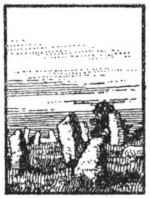
The Druid Stones at Stanton Drew.
[Pg 48]
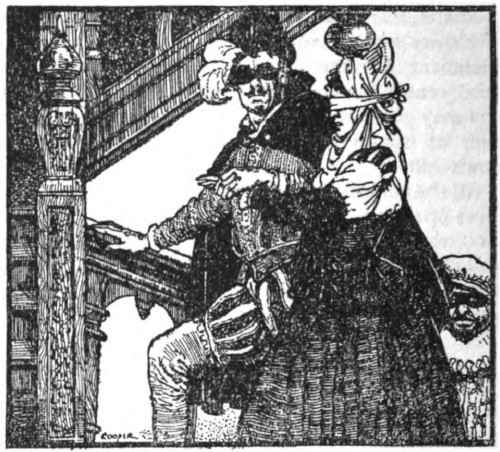
THE STORY OF WILD DARRELL.

here is a strange story told of Littlecote Manor, a glorious old Tudor mansion that lies not far from the pleasant little Berkshire town of Hungerford. This, in Elizabeth’s time, was the ancestral home of the Darrells; but “Wild Darrell,” the last of them to hold it, had to sacrifice the place to save his wicked life. At least so the old tales tell.
This grim story begins with the awakening at dead of night of the village nurse at Shefford, some seven[Pg 49] miles away from Littlecote. Masked messengers bade her come at once to a waiting coach to tend a lady “not far away.” She was to ask no questions, she was told, and she must submit to be blindfolded until she reached her destination. But to compensate her for this strange treatment a heavy purse of gold was offered. The nurse, torn between emotions of fear and greed, accepted; and the coach set off.
After a long drive through the winter night, the lumbering vehicle at last came to a halt. The blindfolded nurse was led up a great staircase and, when her bandages were removed, she found herself in a richly furnished bedroom where lay a masked lady in a huge four-post bed.
The nurse had no idea where she was, but her natural curiosity had caused her to make whatever mental notes she could. For one thing she counted the steps leading to the bedroom; for another she managed, while going about her work, to clip off a small piece of a heavy curtain which screened the window of the room. But of this later.
In due course there came a new born baby into the world. But fearful as the nurse had been at the mystery of the whole affair, she was terrified at what followed, for when the child was but a few hours old there came to the bedroom a man of ferocious manner, whose face, like those of all with whom she had come in contact, was masked, and snatching the child from the mother’s arms, barbarously killed it.
The nurse, in her horror, swooned; and when she regained consciousness she was being carried from a[Pg 50] coach at the door of her own cottage. Before she could recover her wits the coach had gone, and she was left unable to decide whether the whole affair was some horrid dream, or whether she had really witnessed the terrible scene which had burnt itself into her memory.
But the discovery in her hand of the promised reward proved to her that it was no dream.
For some months the nurse kept her own counsel, fearful perhaps that should she speak she would lose the big reward which she had received. But at last, falling ill, and thinking herself about to die, she made a full confession. Enquiries were made, and the woman taken at last to Littlecote, where she identified the very room in which the crime had been committed. As final proof the piece of curtain she had taken with her was found to fit a hole in one of the curtains of the room.
“Wild Darrell,” they say, was arrested and brought to trial; but he managed to save his life by bribery, giving his whole estate to the judge who tried him in order to secure acquittal. But he did not live long after the trial. Still remaining in the neighbourhood, he gave himself up to the wildest debauchery in an endeavour to escape from the ghost of the murdered infant. Riding about the downs one night, they tell, the wraith of the child suddenly appeared in his path. His horse reared back in fright and threw its rider. The next morning they found him where he had fallen, with his neck broken.
They say “Wild Darrell” still rides the country-side[Pg 51] of nights, and that a baby’s ghost for many years haunted an oak panelled room in Littlecote Manor. But you must please yourself whether to believe this or not.
At any rate Littlecote looks the sort of stately, romantic house that should be haunted. It lies in the peaceful Kennet valley, close by that stream so famous for its trout.
A mile or two away rise the fine open Marlborough Downs with their many relics of ancient civilization. Three or four miles to the westward and you are in glorious Savernake Forest with its silent glades and its world famous avenues. Hungerford itself is a quiet, tidy little market town, little known to the tourist, yet a wonderfully convenient centre for visiting the country that surrounds it. Gallows-crowned Inkpen Beacon is but a few miles off, a hill that misses being a mountain by only forty odd feet.
This is a magnificent country for the fisherman and the pedestrian; its hill tops are as lonely as the Welsh mountain summits, its leafy woods as unfrequented as an Alpine forest. Yet you may reach Hungerford in under a couple of hours from London; see Littlecote, the scene of “Wild Darrell’s” terrible action, wander over the hills, and return to Town between breakfast time and dinner on a summer’s day.
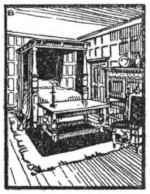
The Haunted Room at Littlecote.
[Pg 52]
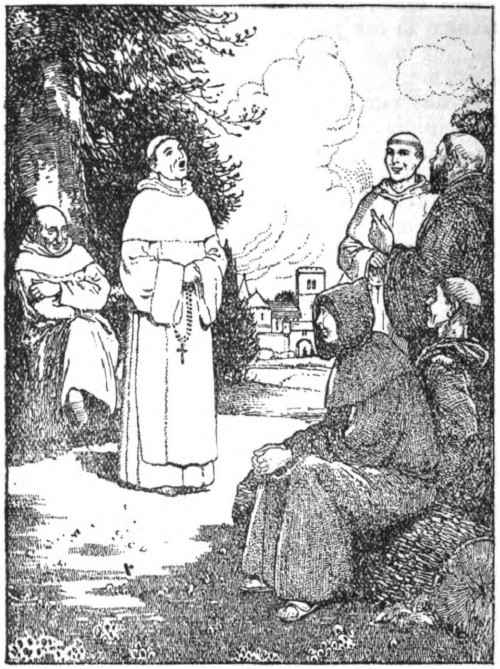
[Pg 53]
A SONG OF THE XIII CENTURY.

omewhere about 700 years ago, a monk in famous Reading Abbey composed a song in praise of Spring. Its words and music were written down at the time and you may see them to-day at the British Museum.
That song—they call it our oldest song—was “Sumer is icumen in,” and its author, antiquaries believe to have been, one John of Fornsete. They say this famous ancient “Round” was written some time between 1226 and 1240 when King Henry III was on the throne, and when the signing of Magna Carta was but a few years old in the memory of living men.
This is a wonderful old song, very simple, yet somehow bringing up a picture of the unchanging Spring as it came those centuries ago to the river meadows of the silver Thames, that stretched away from Reading’s mighty Abbey, then a comparatively modern building, little more than a hundred years old. And some young brother, at work in the fields perhaps, overjoyed to see the sun and the green leaves again, finding expression of his joy in song and music.
To-day you may still find many remains of that stately Abbey at Reading, which became one of the richest in the land. Its inner gateway still stands and its guest house, as well as many ivy clad ruins of its other buildings.
And Reading, for all its busy modern life retains much of its old-world atmosphere in its fine churches and queerly named streets. And here, too, you will find, in the Museum, relics of Roman Britain unequalled in England, for to Reading have been brought the treasures excavated at Roman Silchester a few miles away, the buried city sometimes called the British Pompeii.
The neighbourhood of Reading teems with objects of natural beauty and historic interest, which more than repay the examination of the visitor to this, at first sight, rather modest modern red brick country town. Reading has seen in its time a very full share of England’s history and romance.
[Pg 54]
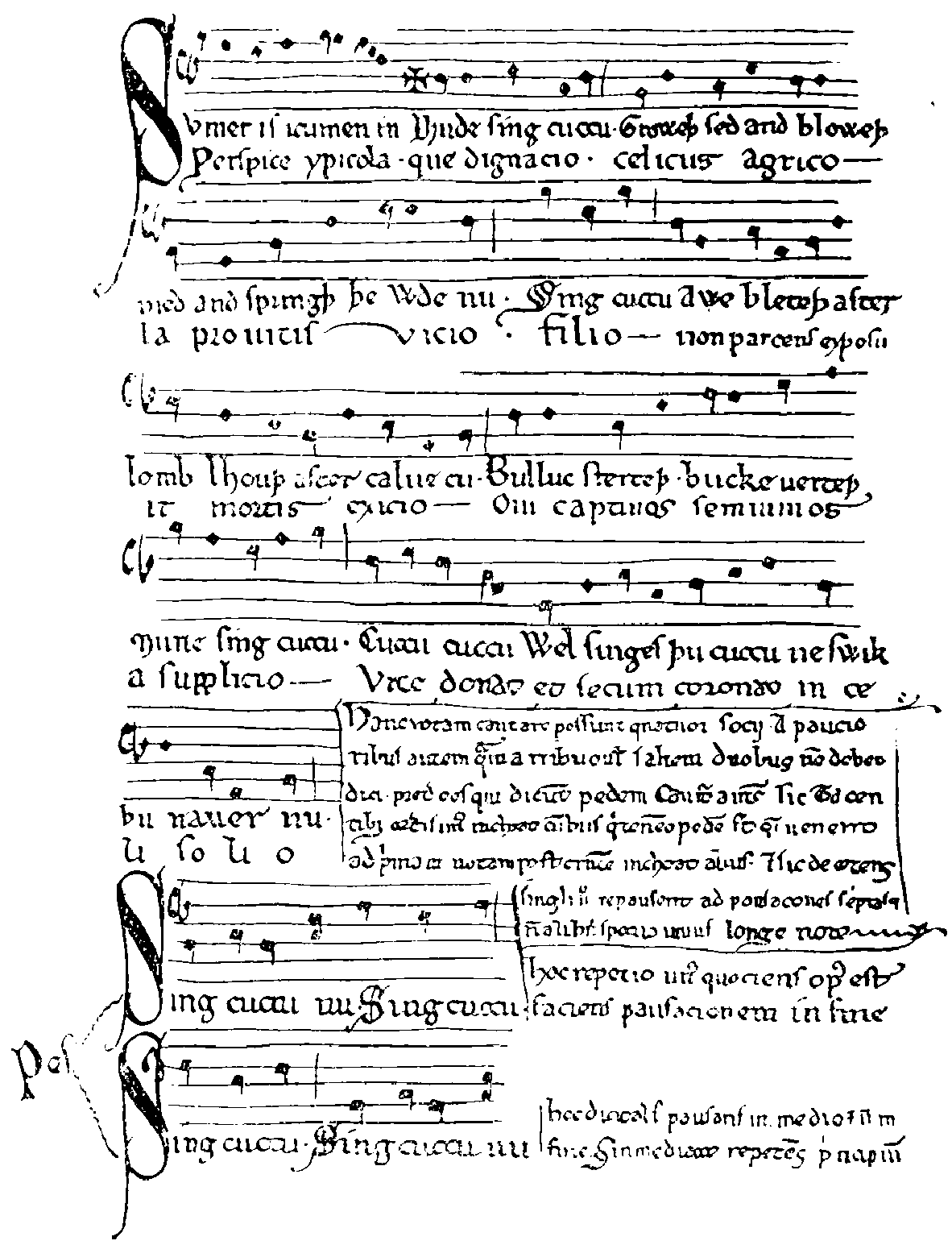
Original manuscript (six voices).
Click on the image to see it in higher resolution.
See Transcriber's Note for this version in modern notation.
NOTE.—The original composition of “Sumer is icumen in” took six persons to sing it. The modernised version given on the next page is for a solo voice with pianoforte accompaniment. In it the old wording has been slightly modernised, the only archaic word occurring being “sterteth” which means “frisketh,” and “verteth” now an obsolete term indicating to go to the vert or the greenwood. “Sumer is icumen in” means literally: Summer has come in.
The old version with the ancient notation, English and Latin words, and instructions as to singing, shows very much the form of the original 13th century manuscript.
[Pg 55]
SUMMER IS ICUMEN IN.
[Pg 56]
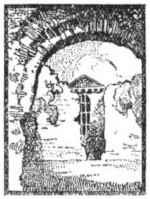
Ruins of Chapter House, Reading Abbey.
![[An illustration showing fairies tending a garden.]](https://www.gutenberg.org/cache/epub/67176/images/back_cover.jpg)
Miniature of the front cover Illustration of Volume Three
TRANSCRIBER’S NOTE
Obsolete, archaic and unusual spellings have been maintained as in the original book. Obvious typos have been fixed silently.
All music in this book was transcribed by Linda Cantoni.
In the song of “Sumer is Icumen In”, press on the [Listen] button to hear the music. As of this writing, it only works in the html version.
The cover page was produced at Distributed Proofreaders from material found in this book. The cover is hereby placed in the public domain.
The author, “Lyonesse” is a pen-name for George Basil Barham.
The following is the original (six voice) version of “Sumer is icumen in” in modern notation.



















































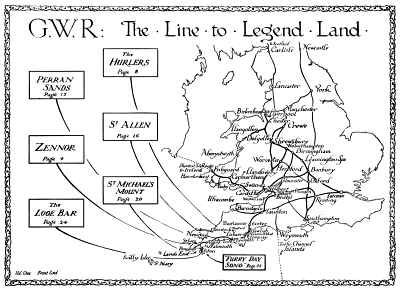
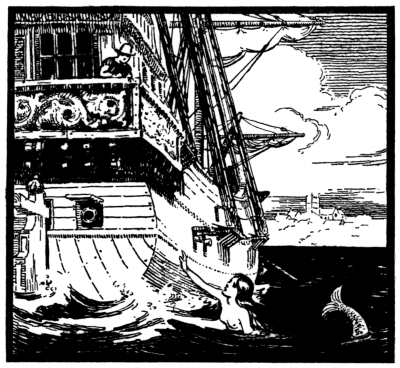
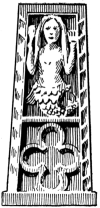
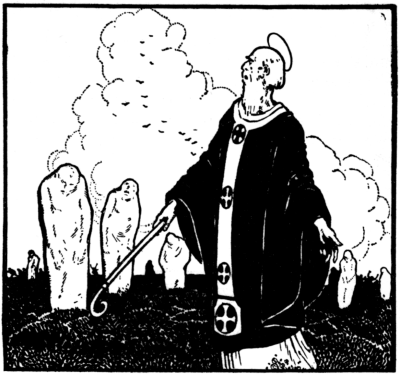

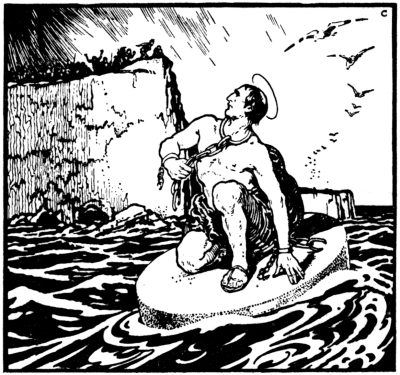
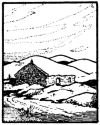
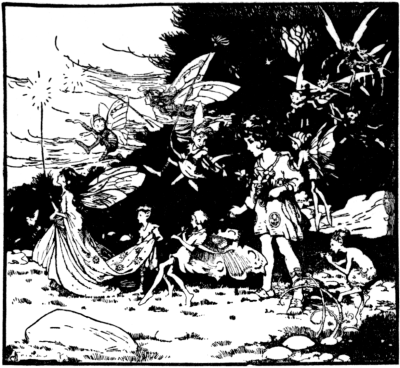
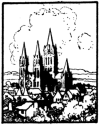
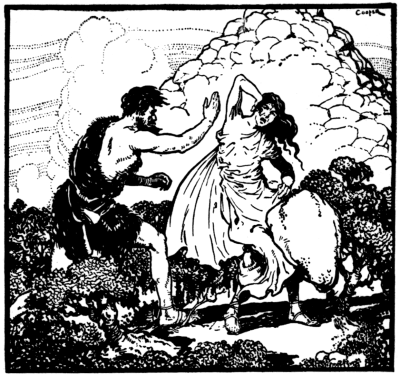
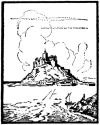
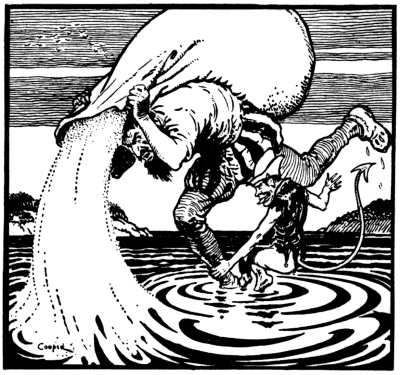
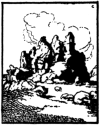
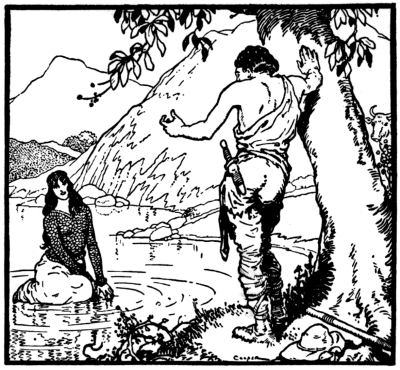

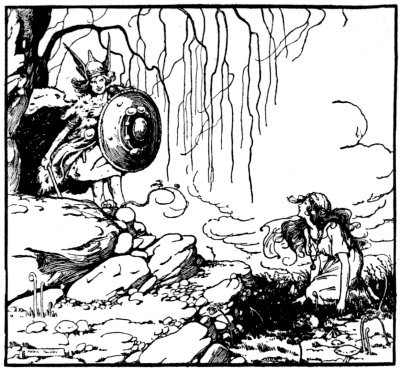
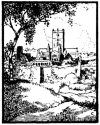
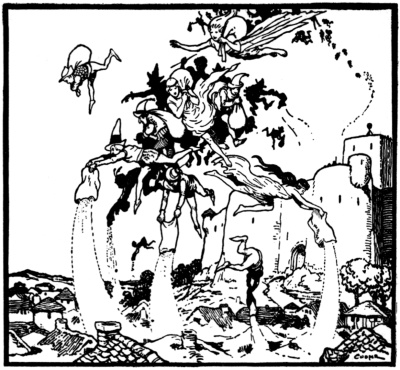
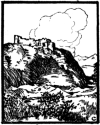
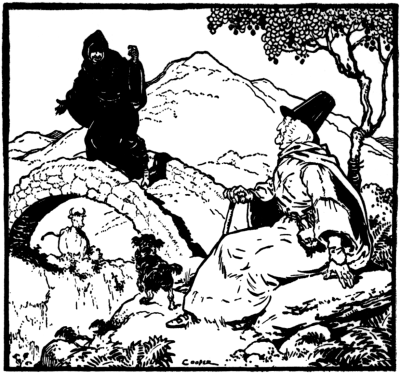
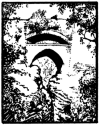

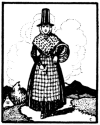
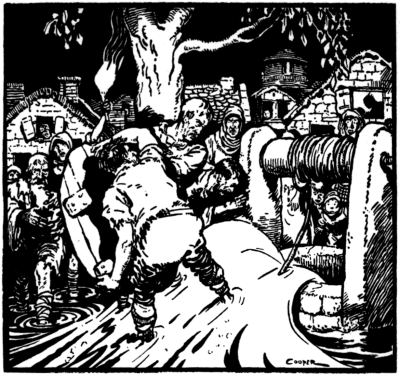

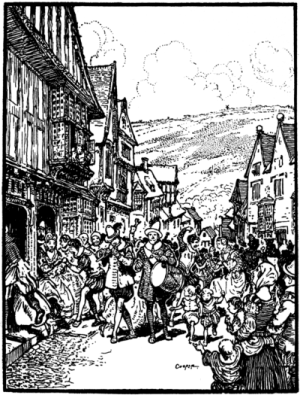
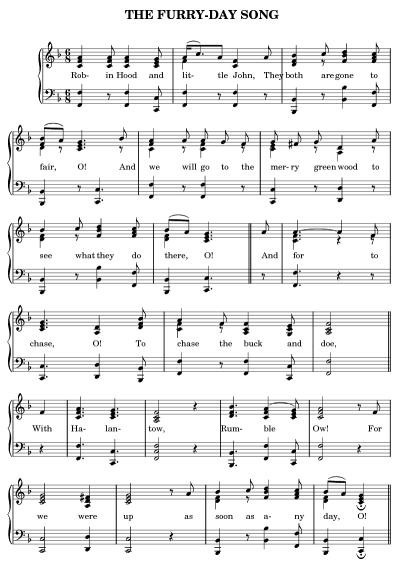
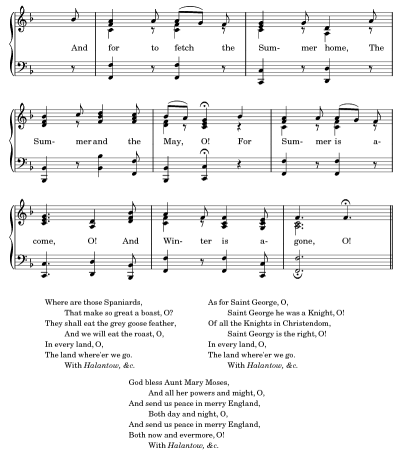

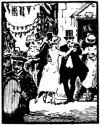
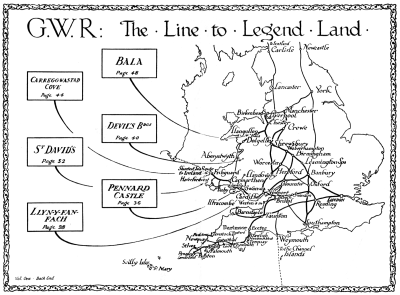



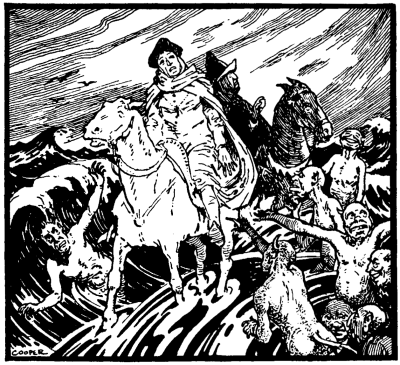





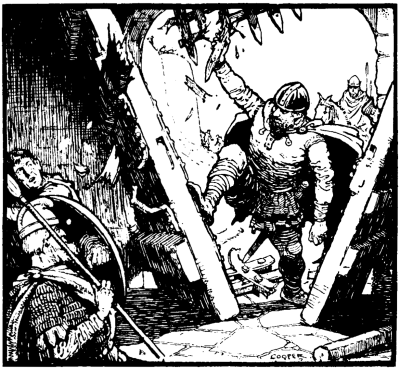
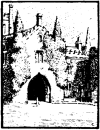









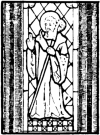
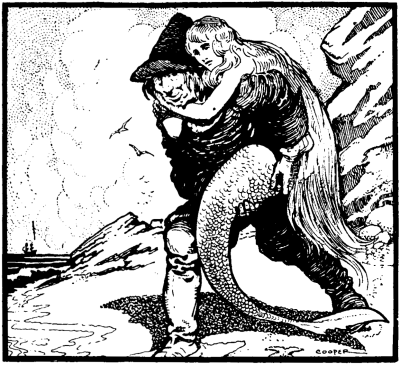

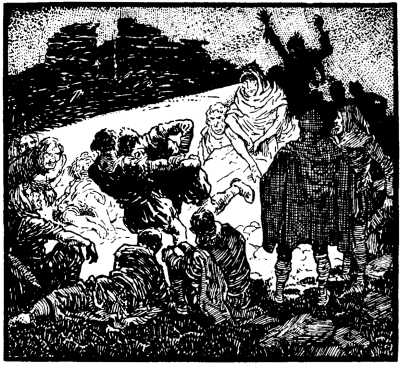
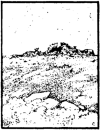
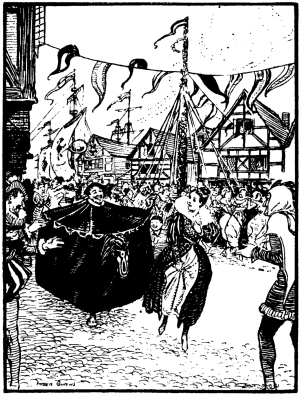


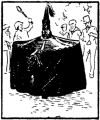


![[Music for the song John Dory.]](https://www.gutenberg.org/cache/epub/67175/images/john_dory.png)
![[Map of central England and Wales, the area covered by the Great Western Railway. Title reads: G. W. R. The line to legend land. Various places mentioned in the book are identified: Trereen Castle (Page 28), Pengersick (Page 36), Rame Head (Page 40), Mevagissey (Page 32), Camborne (Page 44), Newquay (Page 48), Fowey (Page 52).]](https://www.gutenberg.org/cache/epub/67175/images/llv3backthumb.jpg)











